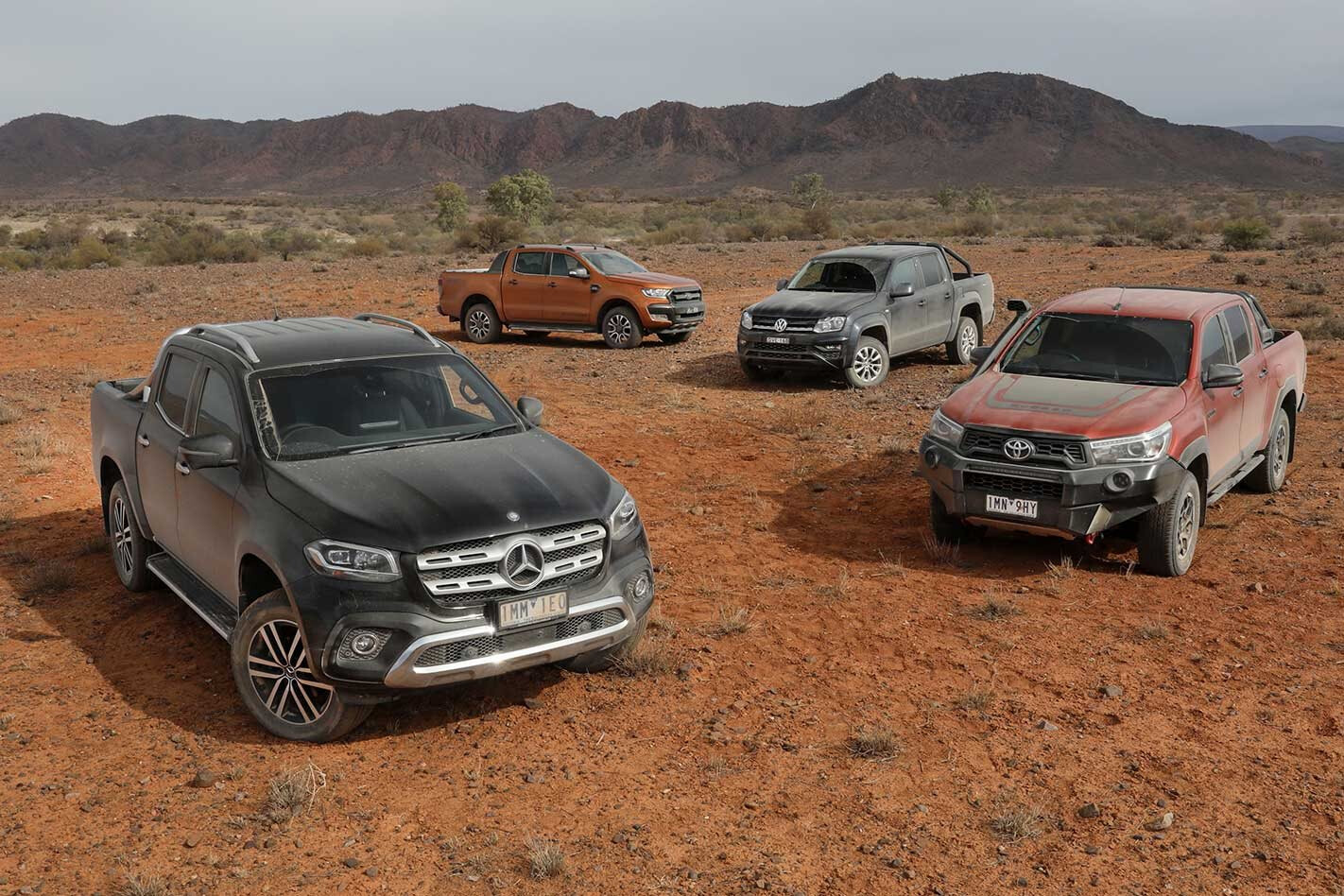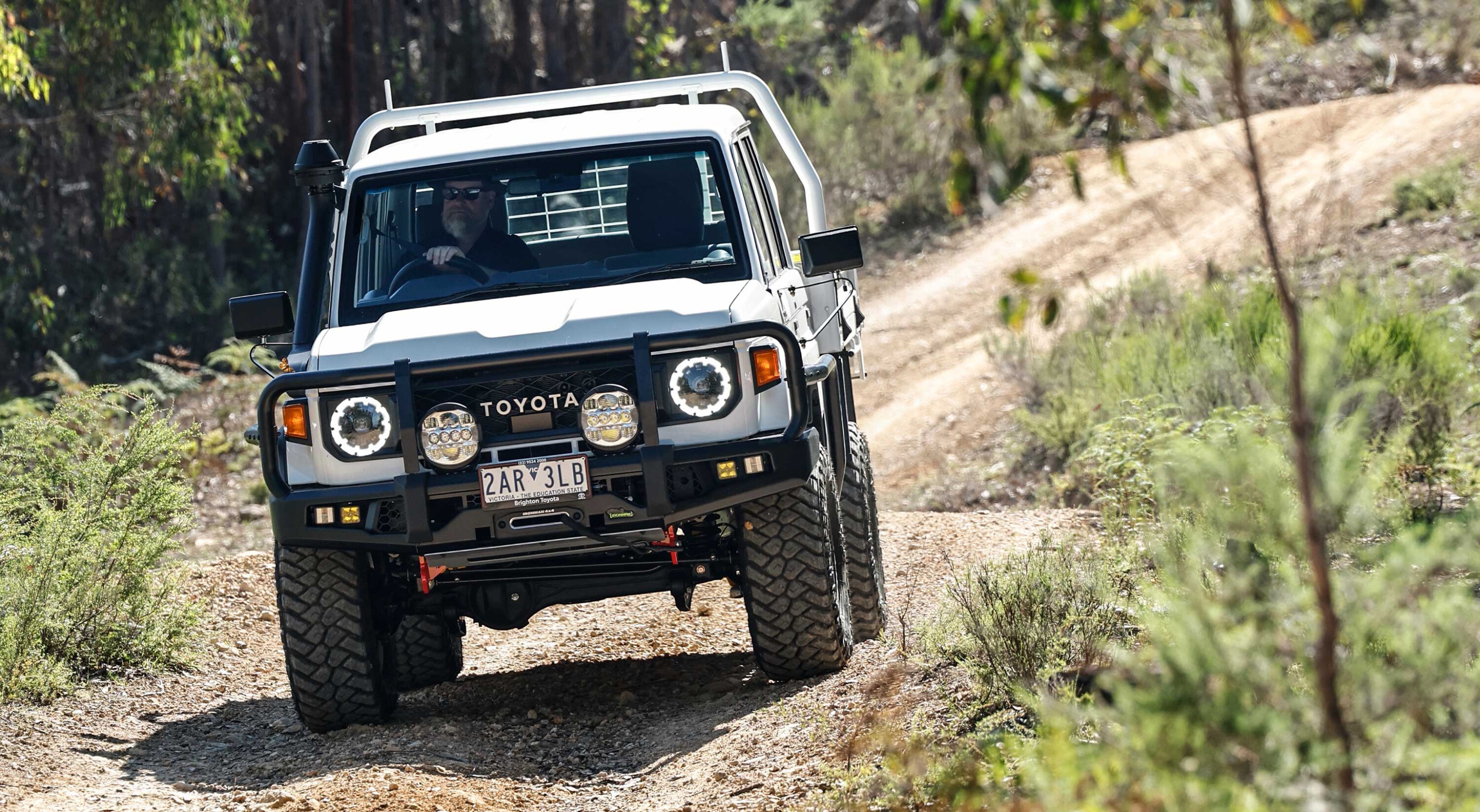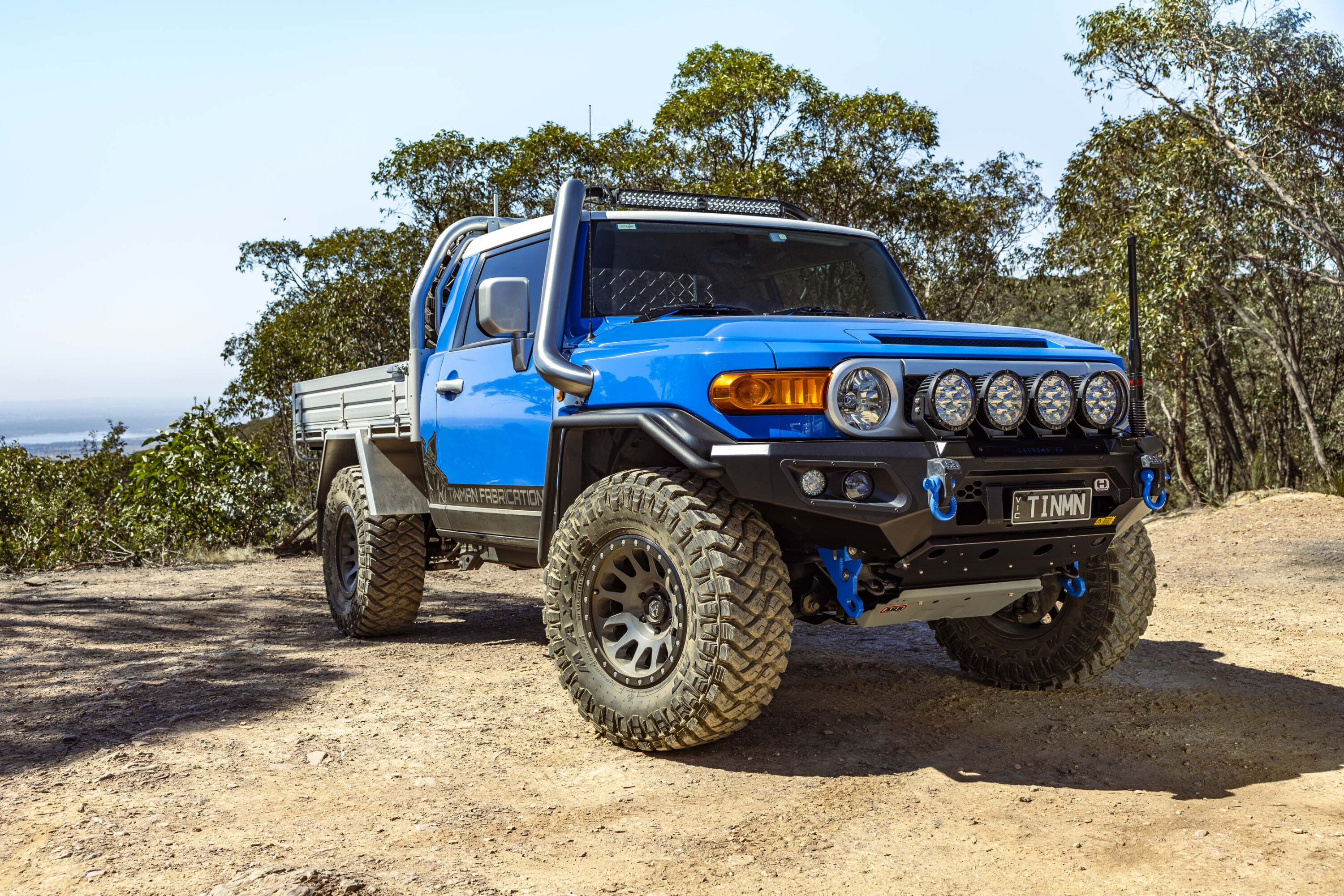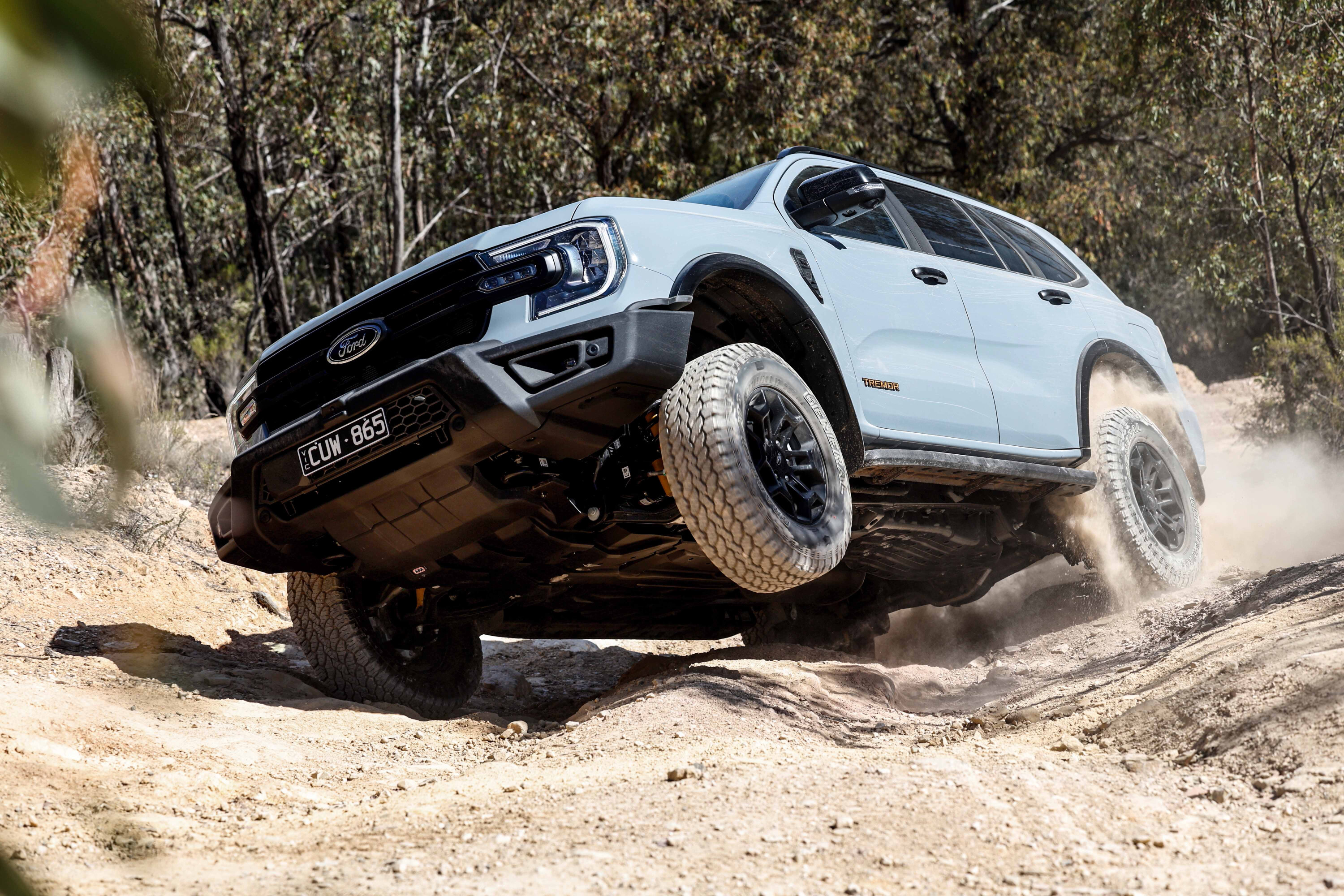IT’S A TOWN of 18 at the northern end of the Flinders Ranges, but that doesn’t stop the people of Blinman taking an interest in the latest newcomer to the 4×4 ute class.
Parked outside the picturesque local pub on a crisp morning, the Mercedes-Benz X-Class has at least one keen admirer, eager to learn more about what is the undoubted darling of the dual-cab class, a category with its fair share of admirers these days.
Alongside the gleaming three-pointed star is the latest addition to the Hilux family, the Rugged X; but the stickers, snorkel and rock rails are simply not getting the attention of an all-new player.
It’s indicative of the shift that’s carving through the ute segment: in its 50 years on Australian roads, the Toyota Hilux hasn’t been under the pressure it’s experiencing now. New players, rejuvenated favourites and beefed-up old timers alike are lining up to take a piece of the turf dominated by the car that first arrived here in 1968.
We’ve also enlisted two of our favourites – the Volkswagen Amarok and Ford Ranger – for the first outback back-to-back test of the latest Benz newcomer. We’ve put these utes through their paces on four-wheel drive test tracks and in the suburbs, and this is our first chance to see how they stand up to the punishment of the outback, from corrugations and washouts to rocks and creek crossings.
In each case we’ve opted for models with plenty of gear, reflective of the changing tastes within that 4×4 segment. Buyers, it seems, can’t get enough when it comes to dual-cab utes. But do they really want something as extravagant as a Mercedes-Benz?
Ford Ranger Wildtrak
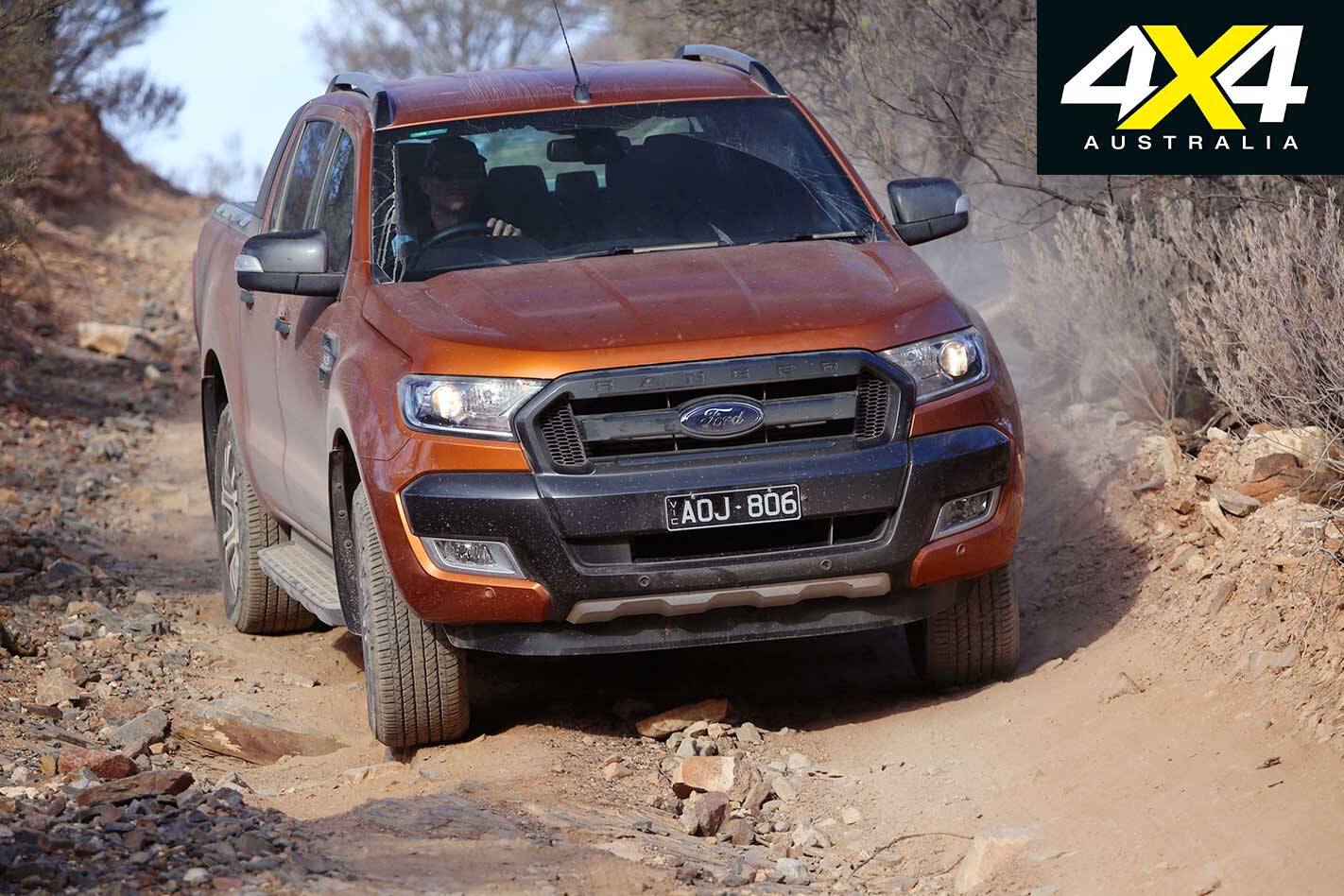
FORD’S clearly done something right with the Ranger. The sales figures reinforce that. What was once an also-ran is now a serious competitor to the Hilux, even outselling it on the 4×4 front in 2017.
On the trip north of Adelaide we’re seeing a stream of Rangers, from basically-equipped workhorses to Wildtraks that have spent more than a few days in the workshop being kitted out with all manner of accessories.
Of course, styling helps. The Ranger looks tough, something that’s important out here. It fits into a rugged landscape, our optional Pride Orange finish blending nicely with the red dirt that’s slowly accumulating in door crevices and wheel arches.
Inside, too, there’s a thoughtful mix of functionality and style, from the eight-inch touchscreen to the orange stitching. The seat trim is also an elegant and rugged mix of leather and technical cloth that suits the nature of the machine; so far it’s been a welcome change to the leather (and faux hide) common once you’re spending this sort of dough.
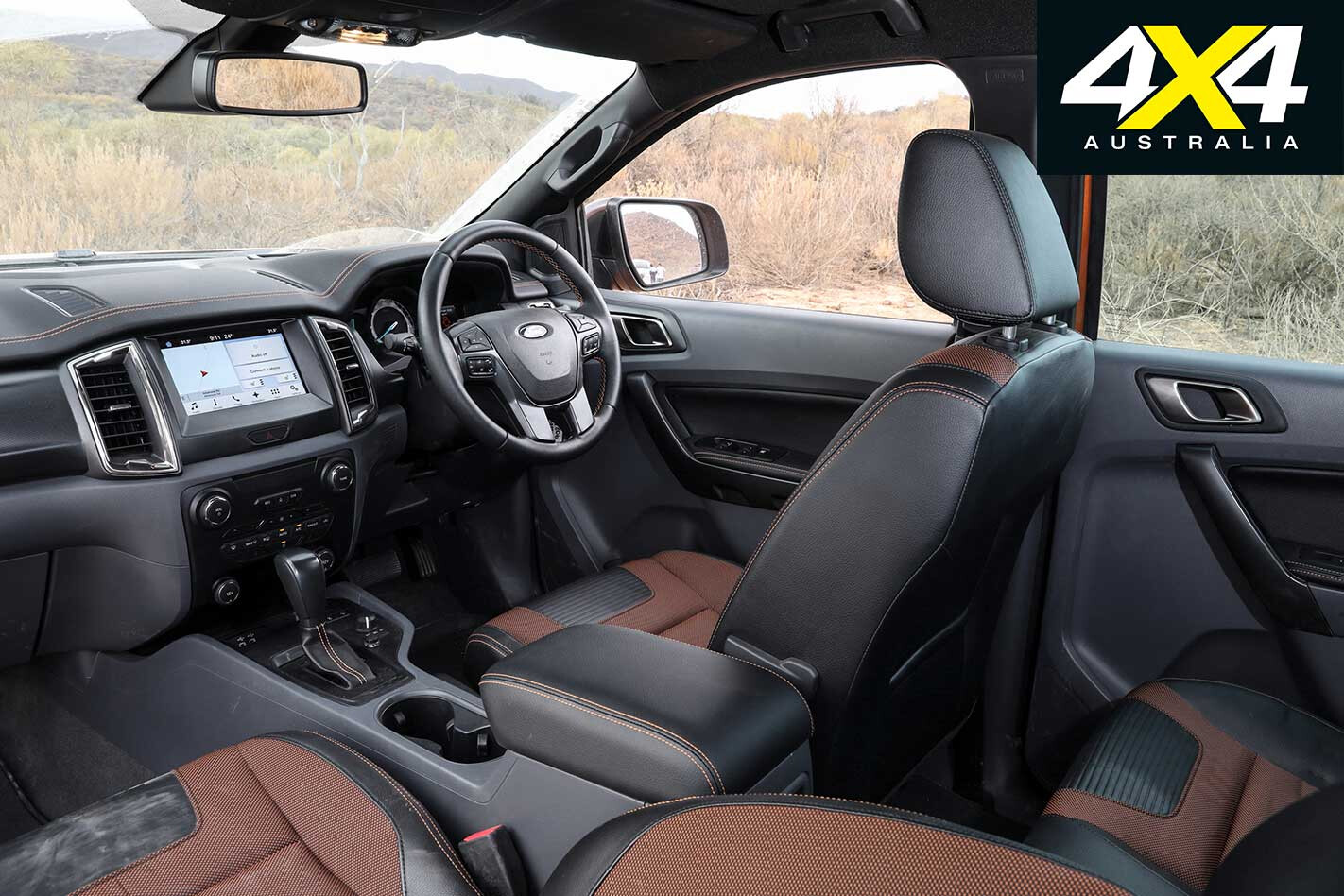
On the long 110km/h drive through the South Australian outback the Ranger’s easy-going nature shines. Comfortable front seats support in the right areas, and even those in the rear get a spacious, well-proportioned cabin; of this quartet it’s the best for backseat comfort, with decent legroom and enough headroom for taller folk. Much of that comes courtesy of the extra millimetres; the Ranger is longer and taller than its rivals, its front and rear wheels also spaced farther apart (only on width is it outdone by all bar the Hilux).
Major controls are also well-positioned and the dials employed for major audio and ventilation functions are a refreshing change from the push buttons (unnecessarily) infiltrating interiors. It’s a shame there’s no reach adjustment for the steering; although, somehow the seating position worked well enough on long expanses.
At $61,790 the Wildtrak is decent buying, especially considering the five-year warranty recently added to the Ford arsenal – it provides an extra two years’ coverage over its three outback rivals. For that you get a towbar (the braking controls to utilise the 3500kg capacity cost extra) as well as Apple CarPlay and Android Auto.
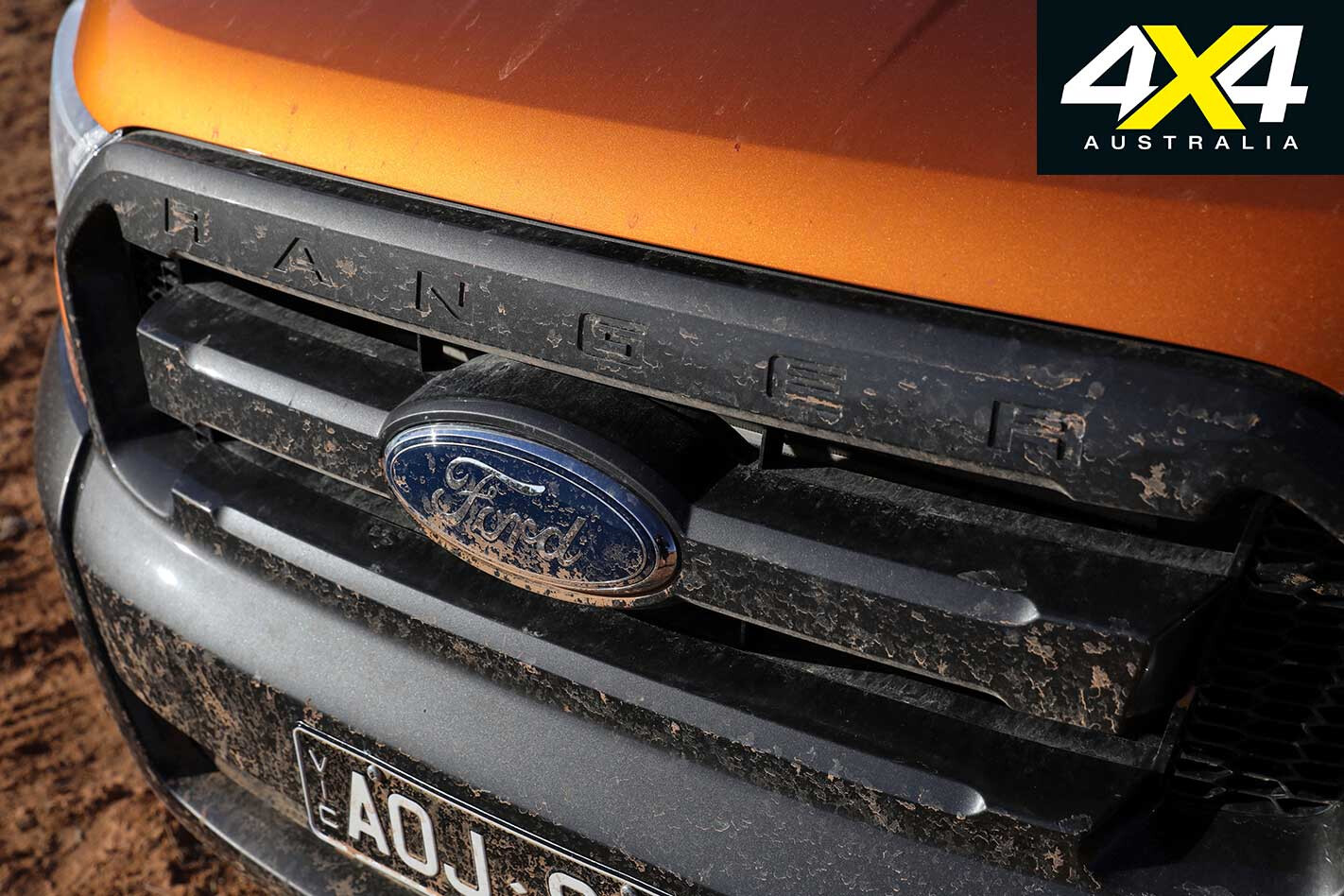
The Ranger is also unique in the class in getting adaptive cruise control. While it’s not as intuitive as a focused human for predicting traffic flow, it’s an easy way to lock onto other traffic for a relaxed ride. Less impressive is the lane departure warning; like every system we’ve tried it’s over-eager to warn of typical movements within a lane, prompting us to switch it off.
However, the farther you drive the Wildtrak the more impressive it becomes, whatever the surface. The standard roller shutter over the tray came in handy early, keeping swags a tad less dusty while allowing for larger loads without the removal of a tonneau. Those seriously loading up will likely remove it, but at least there are choices. The 12V outlet in the lined tub is a win for camping gear, too.
Of course, there’s an updated Ranger coming, one which adds active safety kit (including AEB) and the option of a new 2.0-litre four-cylinder diesel that outpunches the current engine, while also upping the number of ratios in the auto to 10.
That’s important, because with this model the main thing that breaks the ambience is engine noise. The familiar 3.2-litre five-cylinder is a grunty performer, but it lets you know it’s working, chugging away on even mild throttle inputs. After a few hundred kilometres it gets draining.
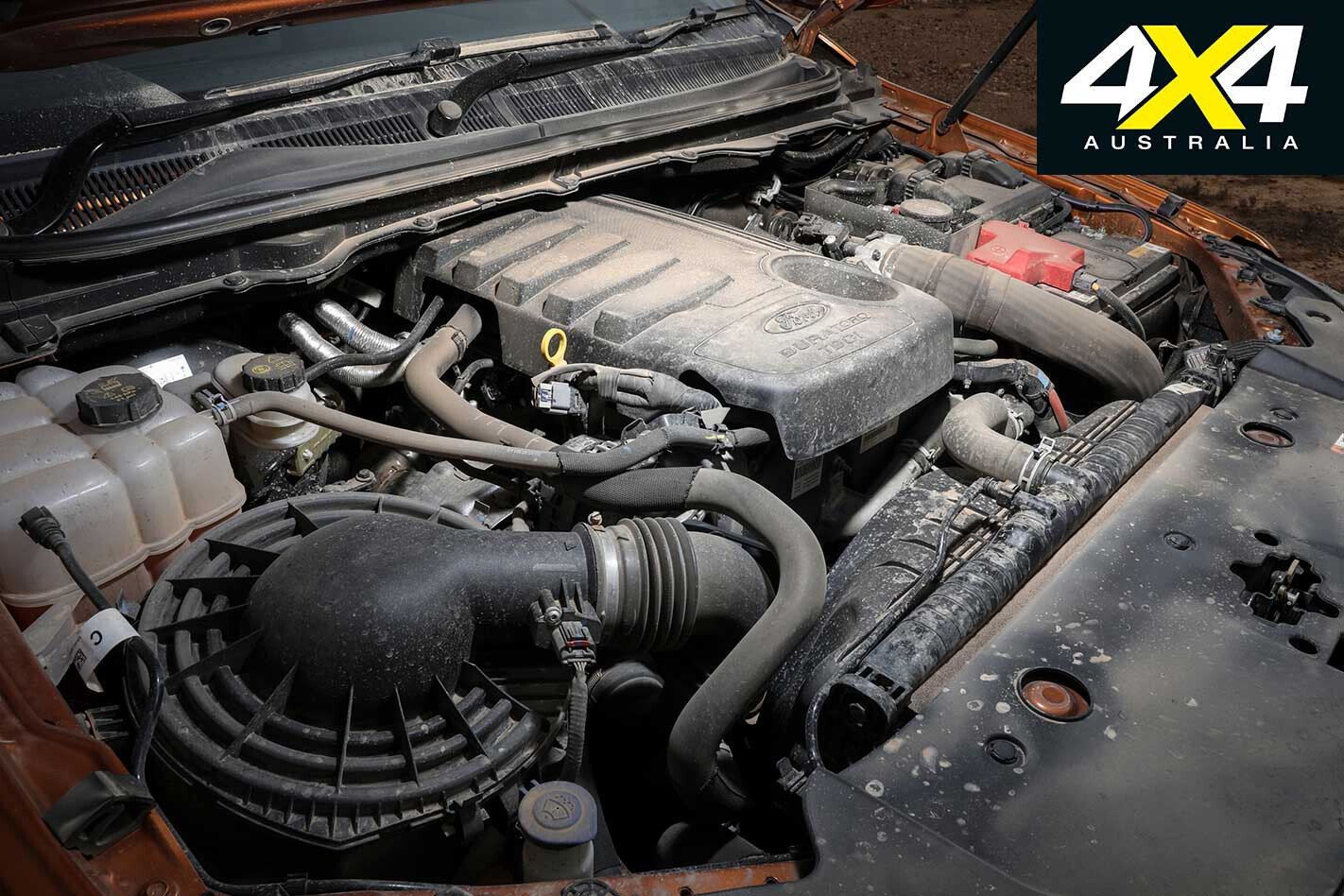
With 147kW and the most torque here – 470Nm – it’s not lacking for punch, helped by the quick response to throttle inputs. Overtaking with the speedo wound into triple figures is also easy, the five-pot ever willing.
That grunt comes at a price, though. Claimed fuel consumption of 8.9L/100km is higher than rivals; our mix of off-roading and cruising yielded figures of 12.2L/100km, which wasn’t bad. And, indeed, the Ranger’s real world fuel use was closest to its claim, suggesting the 80-litre fuel tank will comfortably get you close to 600km between outback fills.
Once the roads get rougher the Wildtrak reasserts itself as a terrific all-rounder. Developed and tuned in Australia, the suspension deals admirably with sharp creek crossings or washouts, quickly settling the body but allowing a degree of suppleness.
Predictable, nicely weighted steering also adds assurance. The 18-inch rubber is a sensible choice, too, allowing the big wheel style that helps set off the exterior but with a respectable 60-profile sidewall for some semblance of protection when off-roading.
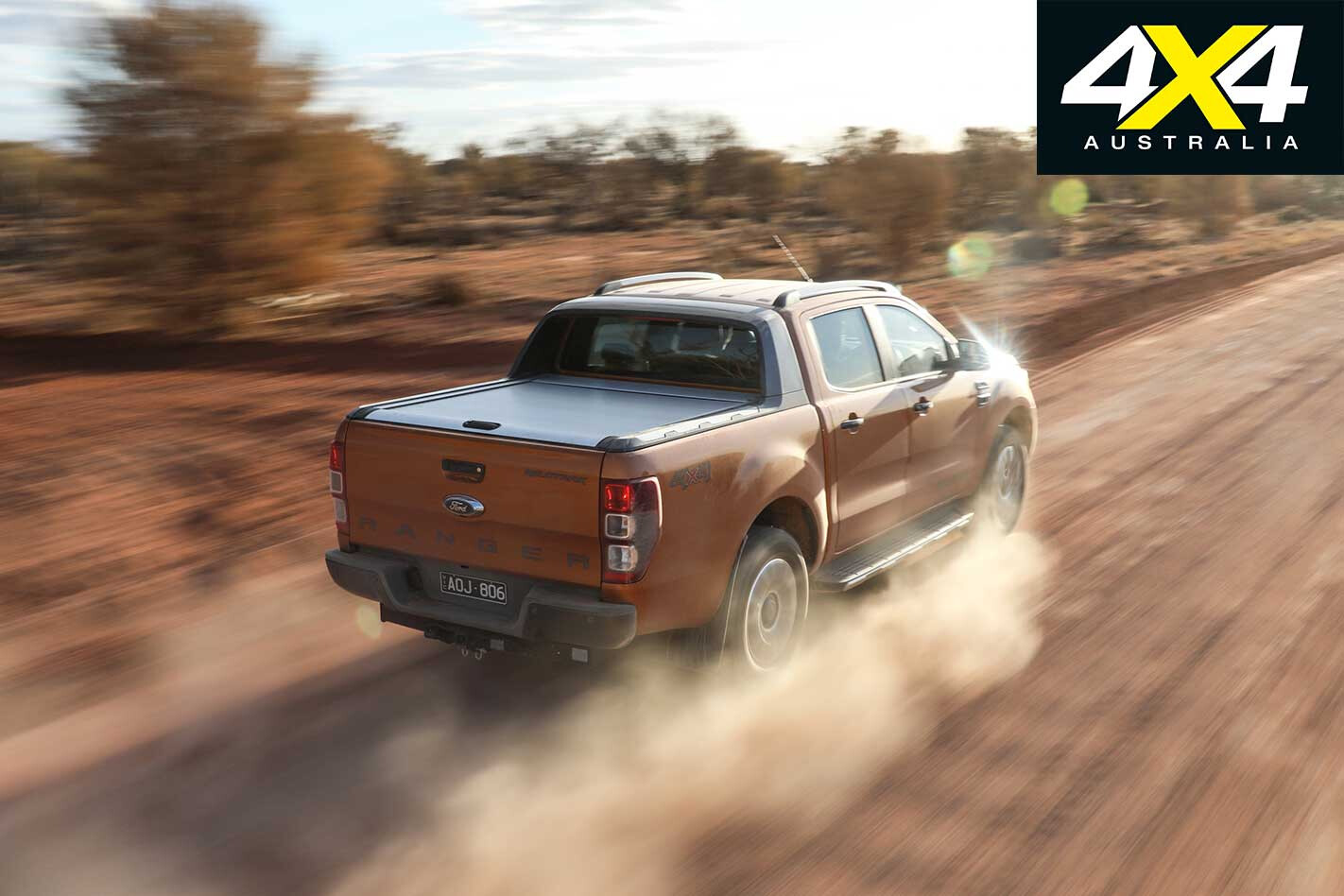
And with low range teaming up with a locking rear diff, as well as good articulation, the Ranger steadfastly resists attempts to cock a rear wheel. However, it’s the all-round nature of the Ranger that made it the car we were happy to slip back behind the wheel of, whatever the surface and whatever the challenge.
2018 Ford Ranger Wildtrak Specs: Price: $61,790 (as tested $62,340) Engine: 3.2L 5-cyl turbo-diesel Power: 147kW @ 3000rpm Torque: 470Nm @ 1750-2500rpm Departure Angle: 21° Rampover Angle: 25° Approach Angle: 29° Wading Depth: 800mm Ground Clearance: 237mm
Mercedes-Benz X250d
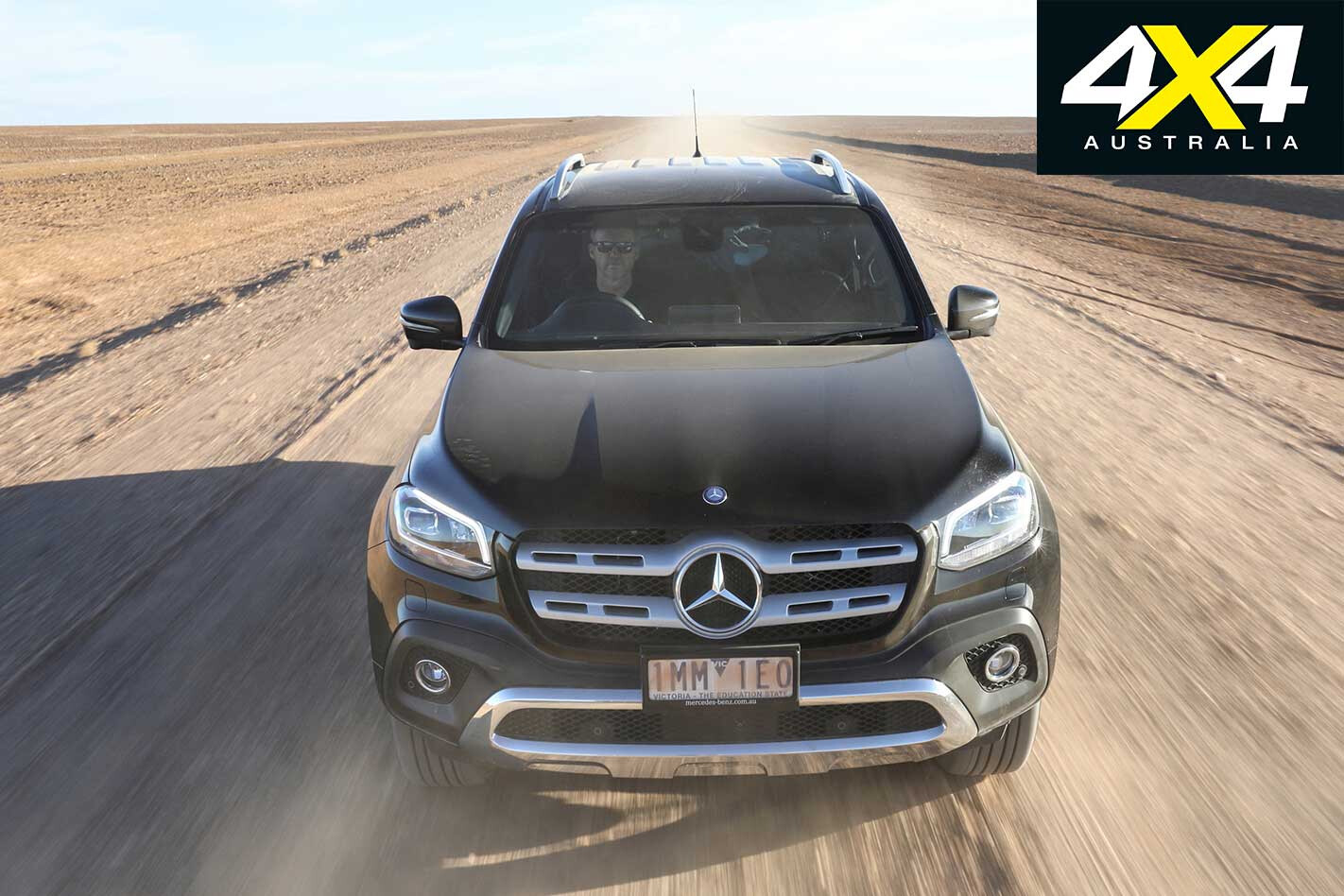
IT MAY have a luxury badge, but the X-Class comes with the same tough genes as other utes – ladder-frame chassis, one-tonne payload, 3.5-tonne towing capacity – which can make its entry price difficult to swallow.
The most affordable four-wheel drive with an auto transmission and the trayback tail will set you back $55,300, which is more than any four-cylinder Amarok. For that you get steel wheels, black bumpers and a vinyl floor.
By the time you stretch to the flagship Power we’re piloting it’s a $64,500 proposition. Even then, you can easily add thousands more; our car, for example, had a black roof lining, aluminium dash trim, a tray liner and a sports bar, things that pushed it well beyond $70K.
Fortunately, the X-Class fights back being the first ute to offer autonomous emergency braking, which uses a camera and radar to monitor vehicles ahead and automatically hits the brakes if you forget to. It’s more useful during our nose-to-tail grind from the southern capital, but it may still be handy on country roads. However, peeling on to the craggy Flinders roads it suddenly seems a lot less useful.
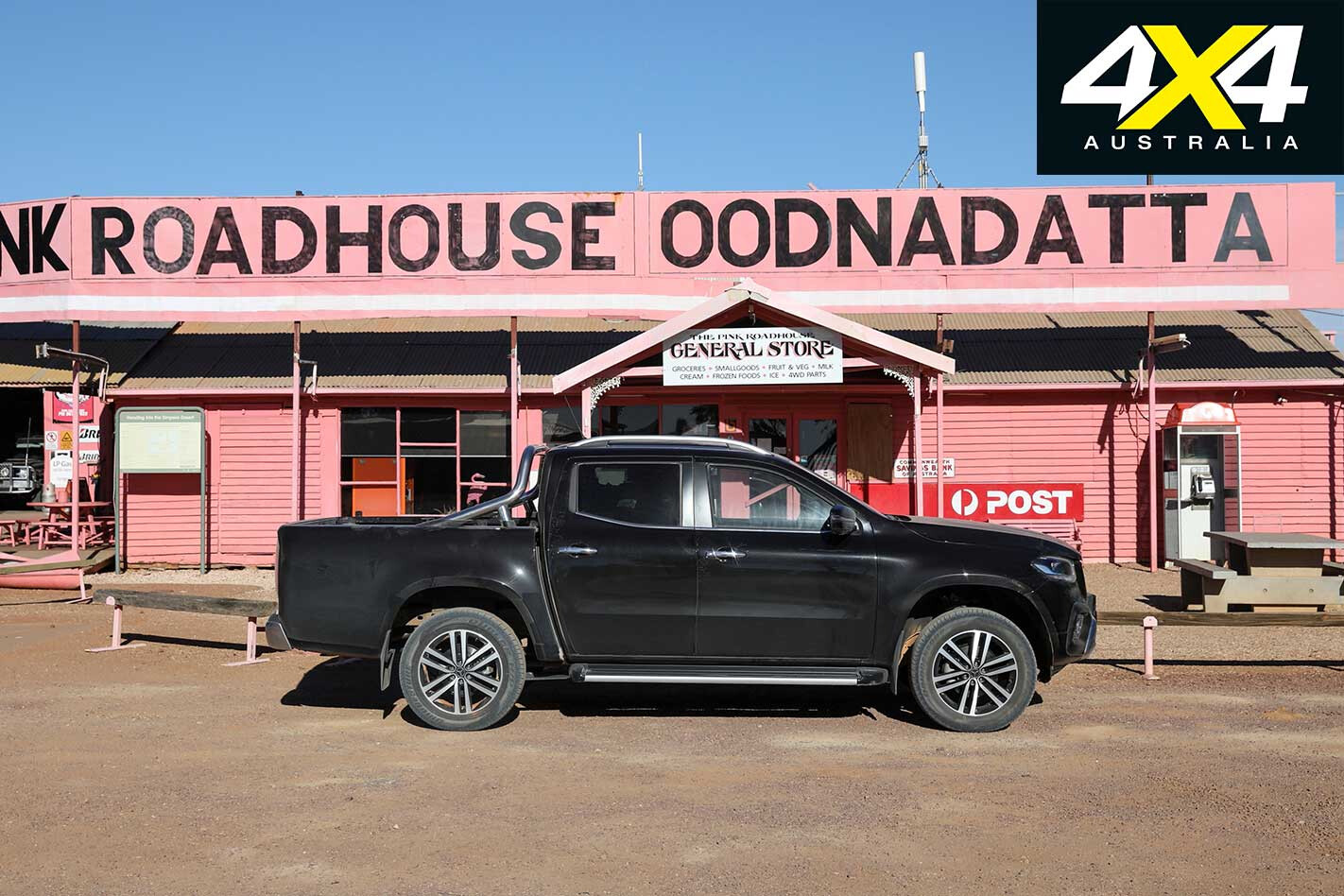
No major qualms with how it deals with rough roads, though. The X’s supple yet well controlled suspension contains things nicely, with decent control blended with comfort. That it’s also the quietest of our contenders adds to the ambience. In widening the cabin compared with the Navara it’s based on, Mercedes has also injected more sound-deadening, something that has paid genuine dividends.
On bitumen and dirt it’s noticeably quieter than its rivals, the only annoyance being some air rustling off the driver’s window.
It’s the optional 19-inch tyres on our car that took the gloss off the rough road ride. At 255mm wide, the tyres don’t add any more width to the 18s that come standard, but they lower the profile to 55, slightly reducing their off-road suitability. Their size also makes it trickier to find replacement rubber easily in remote areas.
Like the Navara it shares so much with, the X runs coil springs at either end, and it’s the rear-end that has question marks hovering over it. We trialled it with more than 900kg in the tray and it wasn’t pretty. The tail sags noticeably, pushing the body onto its bump stops at the limit.
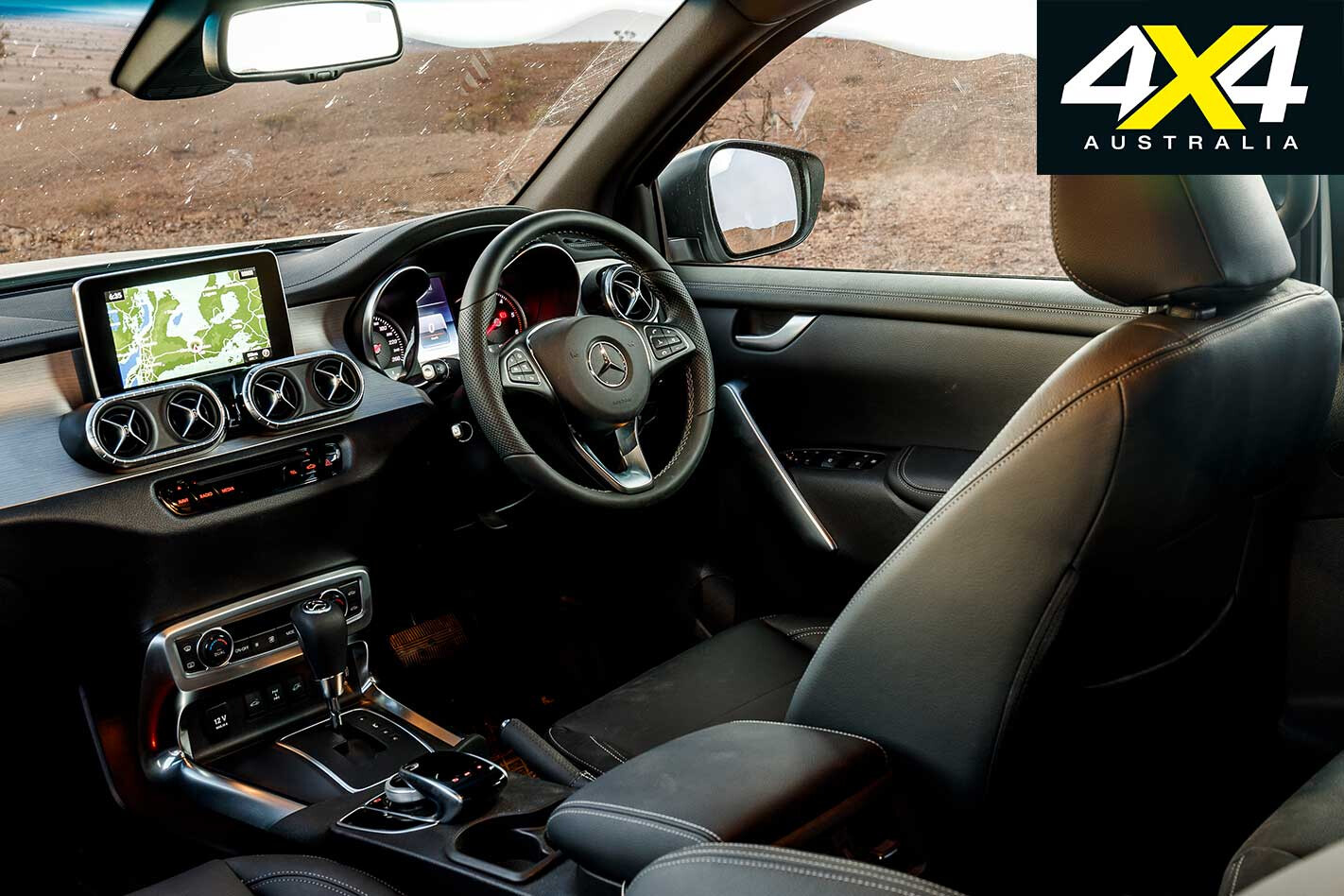
The control it’s afforded with under light loads is suddenly not there, the rump lurching from side to side. For most of our running, though, the X-Class is lightly laden, so there wasn’t an issue.
Under the bonnet the X-Class is pure Nissan; although, Mercedes has gone to reasonable efforts to disguise the fact. A plastic cover boldly displaying the three-pointed star greets those who pop the bonnet. Beneath it is a 2.3-litre twin-turbo four-pot diesel. Outputs are nothing special at 140kW and 450Nm, and they’re challenged by the weighty X-Class frame.
The smooth-shifting seven-speed auto helps, but the X250d never feels particularly punchy, instead relying on its torque for building pace faithfully, if not excitedly. At least it’s quiet in the way it goes about its business.
Plus, it soldiers on for many kilometres. As we learnt, the fuel light is super conservative; we’ve never had one blink on, with the trip computer predicting 180km until things come to a halt. At least it gives you time to plan.
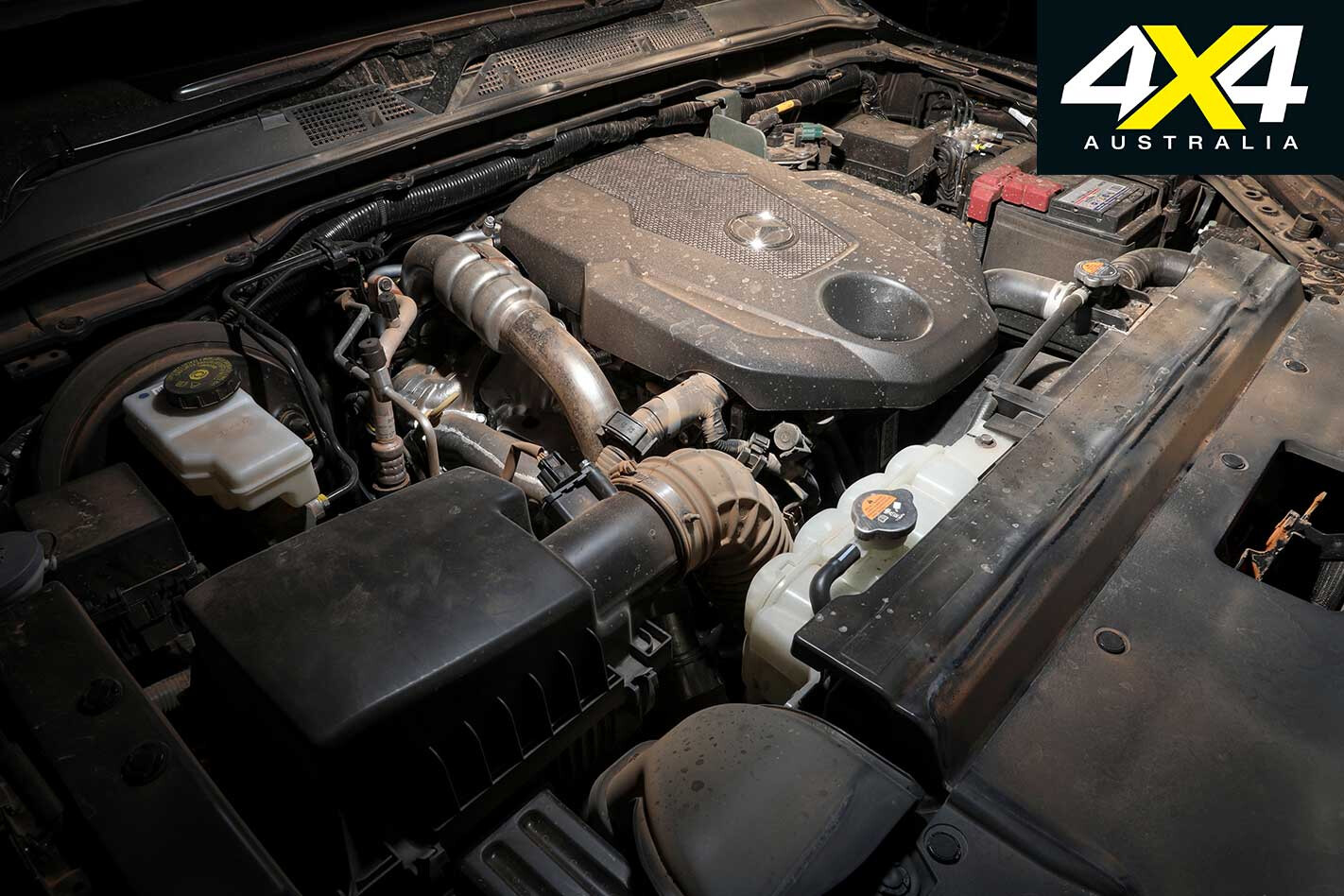
Speaking of fuel use, the X-Class picks up the good part of the Navara genes with its claimed fuel use. The official 7.9L/100km figure is not as impressive as the Nissan (7L/100km), predominantly due to the additional 180-odd kilos it’s lugging. But the 12L/100km return we experienced outclassed its rivals and gave it a touring range approaching 700km.
A puncture late in the trip came at high speed on gravel, but it was quickly picked up courtesy of the standard tyre pressure monitors. Like the Ford, they’re standard, something guaranteed to save a tyre for anyone driving out here regularly.
In other areas, the X feels off the pace. You don’t have to travel far to realise Mercedes-Benz may not have appreciated the intended use of its X-Class as well as some rivals. Cabin storage is light-on, with only a small centre console, cup holders and some door pockets.
By the time you’ve loaded up with a camera, some maps and a phone, you’ll be battling to find somewhere to house them. There are no clever nooks and bins that provide a perfect cubbyhole for anything from coins and cameras to maps or souvenirs plucked along the way. It’s a shame, because elsewhere the X-Class is ready for duty.
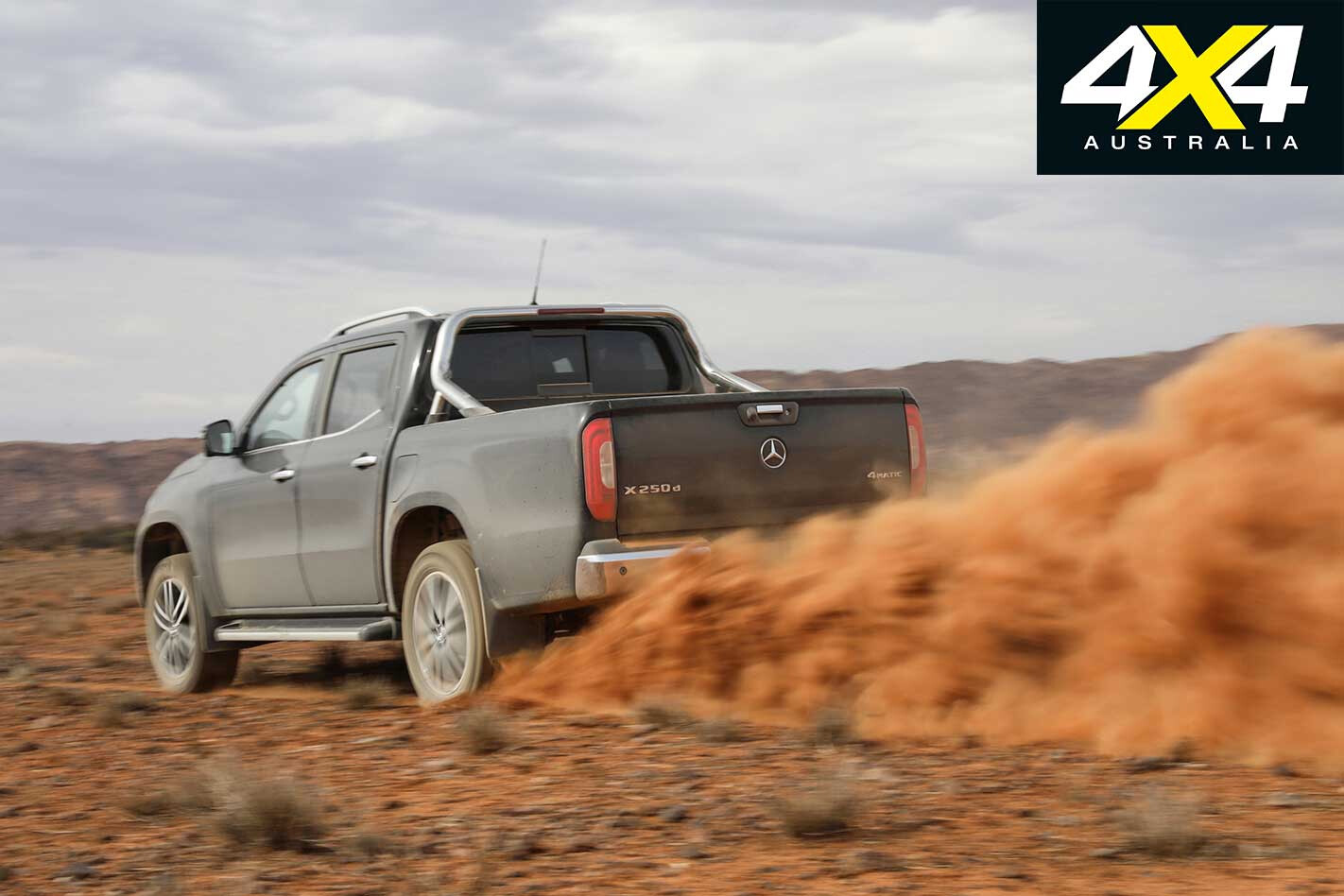
The front seats are terrific, with great lateral support and overall comfort. The lack of reach adjustment on the steering is a rare oversight to the otherwise good driving setup. A few hundred kilometres of dirt roads and the latch for the tailgate started to get sticky, as it was clogged with the fine dust that loves permeating every crevice of a car.
By the end of the trip it was almost impossible to open, with the handle flexing as we wrenched it to undo it. It’s indicative of a car that gets a lot right but trips in some key areas.
2018 Mercedes-Benz X250d Specs: Price: $64,500 (as tested $73,300) Engine: 2.3L 4-cyl twin-turbo diesel Power: 140kW @ 3750rpm Torque: 450Nm @ 1500-2500rpm Departure Angle: 25° Rampover Angle: 22° Approach Angle: 30° Wading Depth: 600mm Ground Clearance: 222mm
Toyota Hilux Rugged X
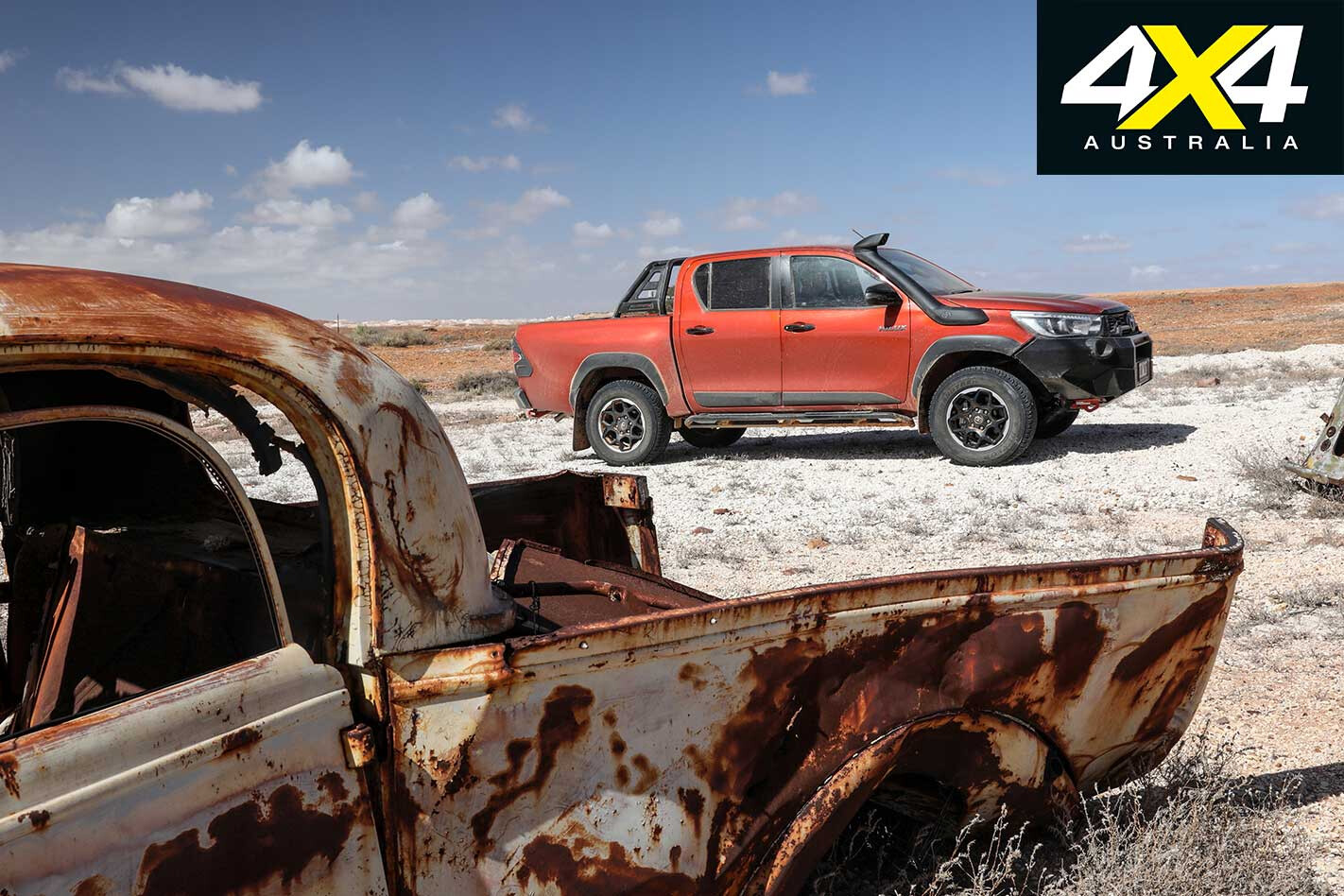
DIRECTNESS in marketing can be a good thing; although, we wonder whether Toyota is getting too literal with the Rugged X, the latest addition to the Hilux range. For the “unbreakable” ute it’s a big call, though it at least states its intentions clearly from the outset, contrasting bonnet stickers and all.
But the Rugged X is a lot more than a sticker pack. What is the pinnacle of the broadened line-up ramps up the ability with rock rails, a sturdier bash plate and a solid steel bumper that promises to fend off a kangaroo or two while housing one of the best standard lighting systems we’ve ever experienced. Between the circular LED spotlights and the broad central light bar, it makes for one heck of a long throw on the vast Stuart Highway.
Elsewhere, the Rugged X is more regular Hilux, from the suspension tune to the engine. That said, the front coils have been beefed up to cope with the additional weight, most of it as a result of that steel bumper. Combined with 17-inch all-terrain tyres that allow more compliance, it makes for decent going pounding over the corrugations the outback does so well.

There’s solidity to the way the Hilux deals with thumps and bumps, its body still shimmying but everything performing as it should. It’s less convincing when riding alongside it and watching how things cope, the front bumper rollicking around within its mounts. It’s then you realise why engineers have left such big gaps between the front guards and the bumper – to allow it to shimmy and shake.
Load it up and the Rugged X is almost as good, the firm suspension losing little in the way of control as it continues to soak up all thrown at it. It’s an impressive bit of kit and one that gives the impression it’ll be doing its thing for many years to come.
That said, it doesn’t take much to hit the load limit for the Hilux. With a quartet of people, their luggage, supplies and camping gear, it’s easy to break the meagre 748kg payload, which is at least 240kg lower than its three bush rivals. While it feels solid approaching that weight limit, unless you turn to the aftermarket there would be issues in breaching it.
From the outset, too, there’s less space in the Hilux. Its cabin is narrower than its three rivals, which combined with the upright dash delivers a more hemmed-in feeling. Not all is rosy elsewhere, either.
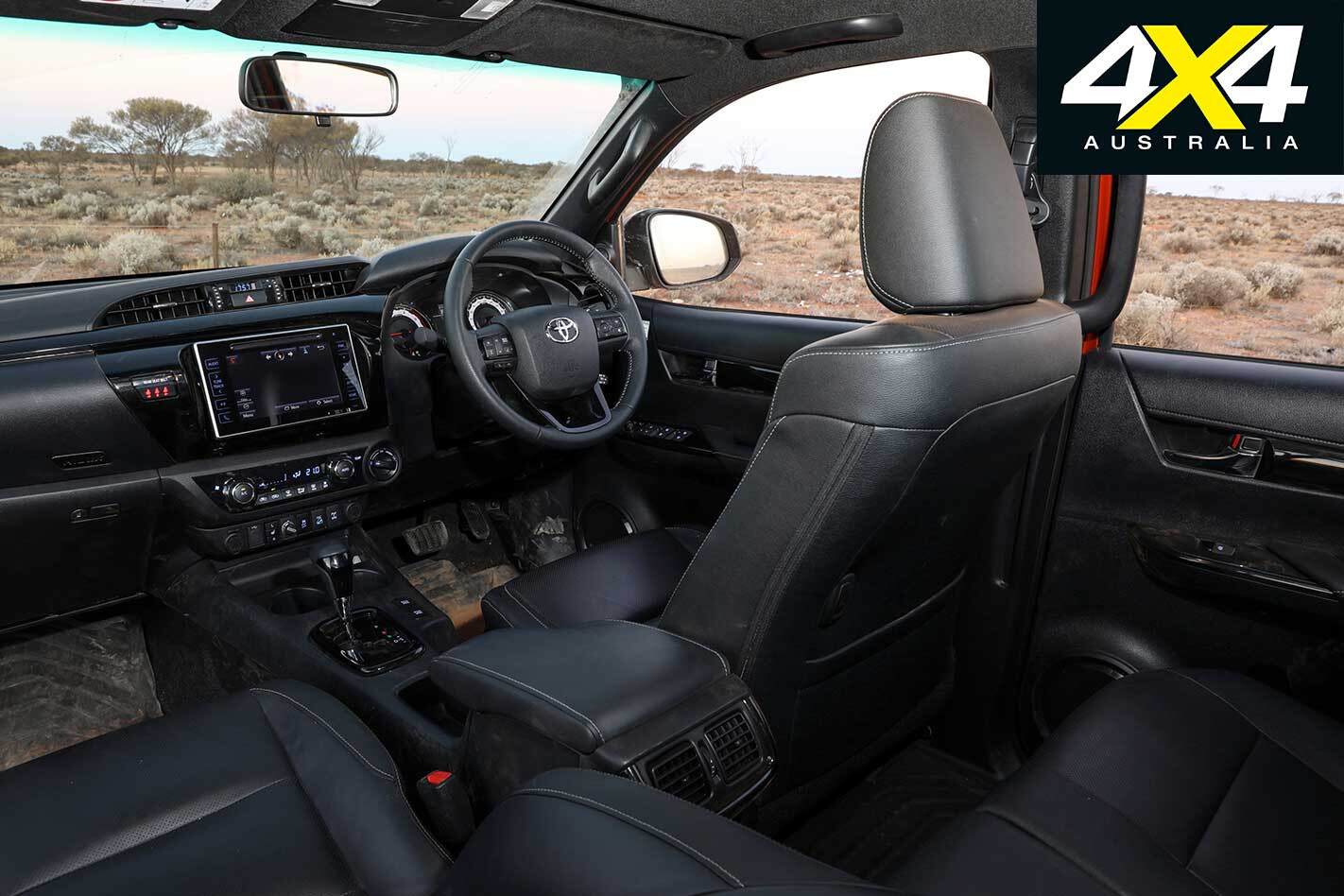
A foot pad from the driver’s side-step kept unclipping, requiring a heartily applied hoof to coax it back in place. And the instrument cluster somehow rattled loose, the cowling covering things such as the 4×4 and high-beam lights. We’ve done tens of thousands of kays with Toyotas out here and never experienced anything like this.
There was worse to come. Punting along an undulating gravel road, our Hilux suddenly flashed up warning lights, including from the stability control safety systems. It happened after bouncing into a dry creek bed, the textbook impact shrugged off by the other three contenders. It also warned of reduced power, the engine now revving higher to account for less turbo boost.
We’ve experienced an identical issue before with a Fortuner, with the same engine and chassis. Then and now, disconnecting the battery to reset the warning lights solved the problem, also returning the engine to its former 130kW/450Nm glory.
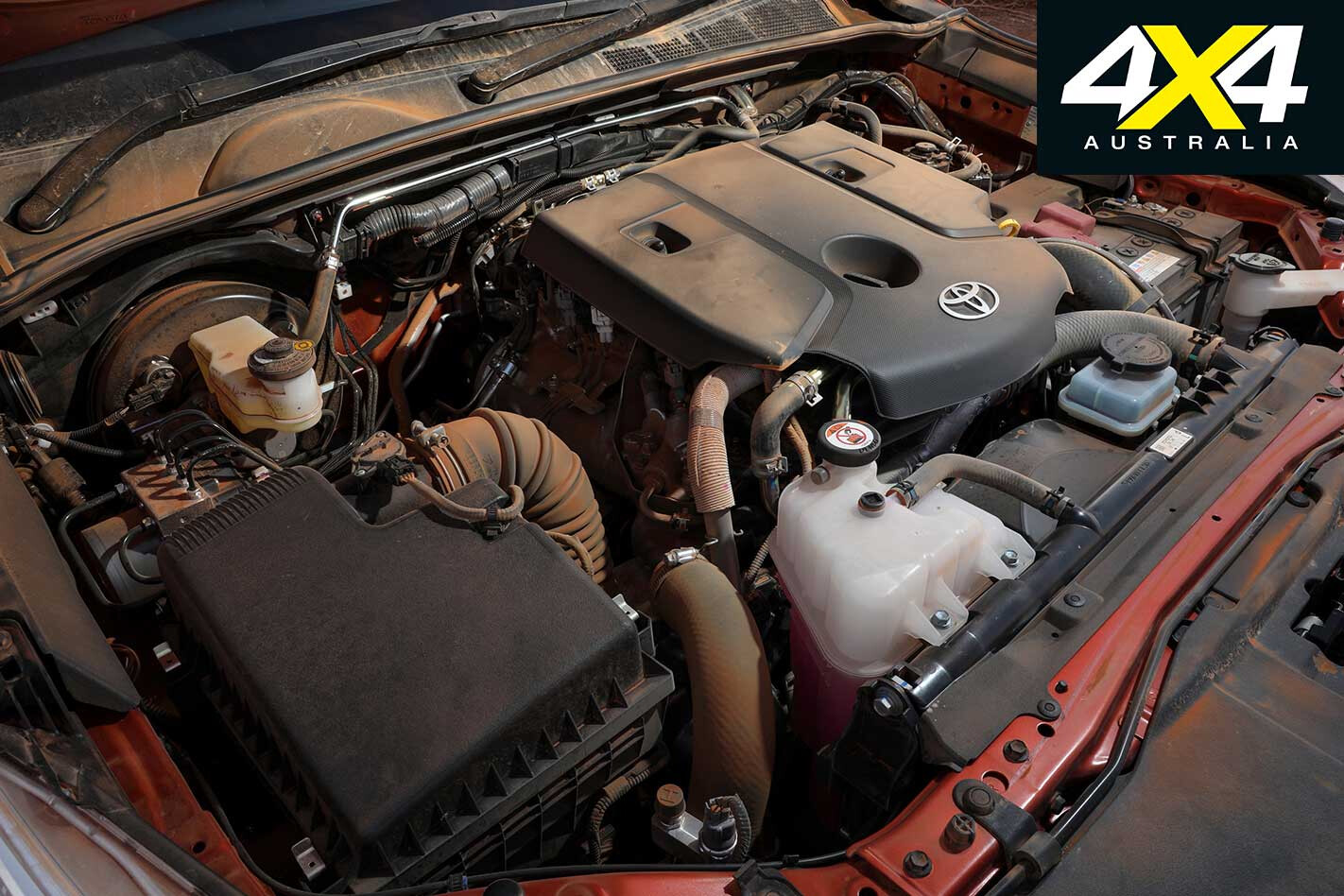
It’s an uninspiring engine, albeit one that gets the job done; its generous low-rev torque by far the hero. It’s a shame about fuel use, though. On paper it looks okay at 7.9L/100km, just four per cent more than an SR5; but the reality is a lot less impressive, with the extra weight of the Rugged X taking its toll.
It was the thirstiest of the lot, slurping 12.6L/100km, and its range reduced more at higher speeds – the Hilux consistently needed its 80L tank topped up first.
Over the next couple of thousand kays our electrical problem resurfaced another three times, all at more than 100km/h when overtaking. It’s disappointing stuff and was a big black mark against a car marketed as unbreakable. Throw in the frustratingly fiddly touchscreen and it was slowly making the Hilux less endearing.
Fortunately, the Hilux wins back points once low range is engaged. Clawing our way through a dry creek bed was a reminder of how intelligent the electronic traction control is, its brain sending drive to scrabbling wheels fighting for traction. The 17-inch all-terrain rubber is also a terrific choice; although, we still picked up a puncture.
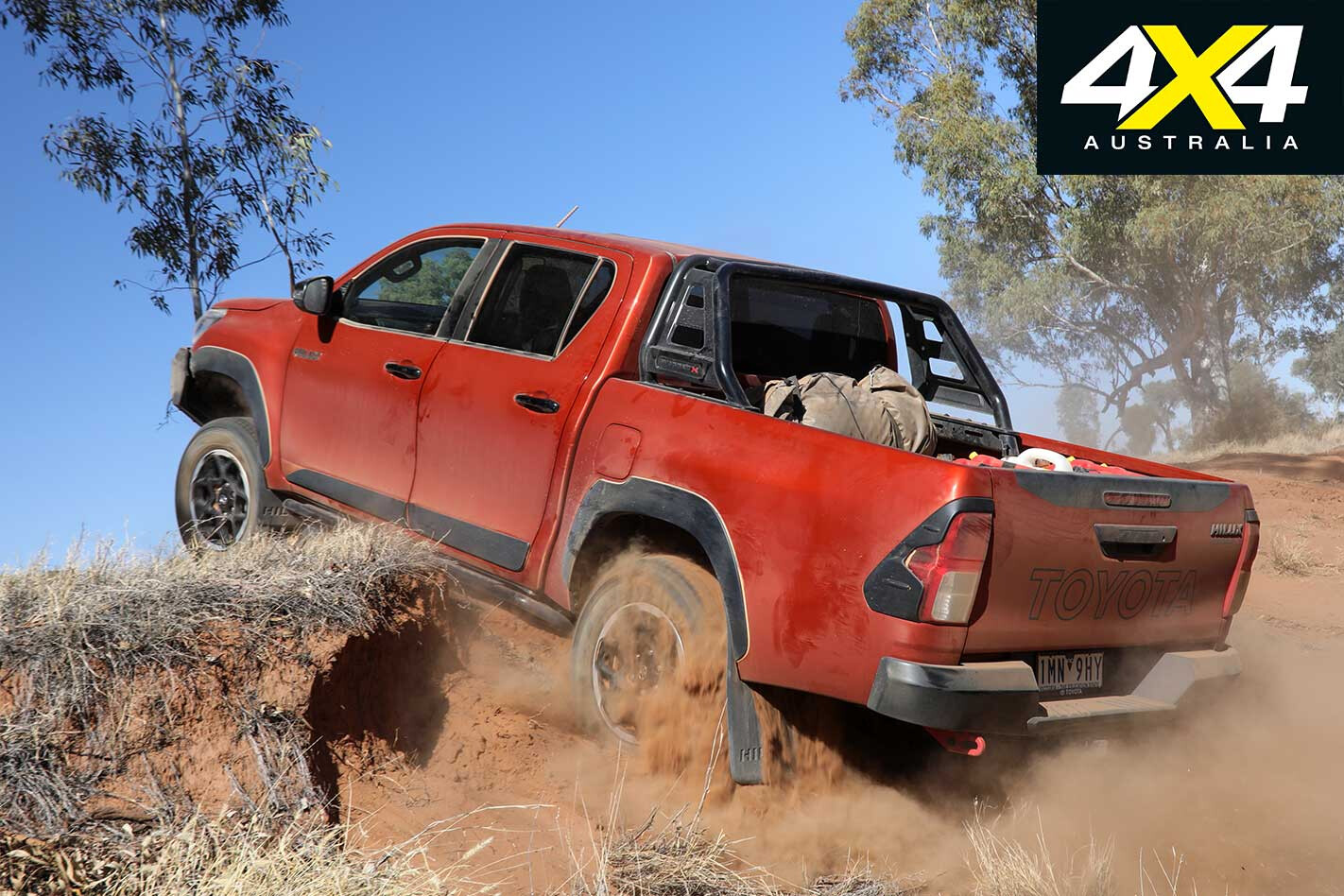
Only later did we need to activate the rear diff lock, a slippery ascent testing the limits and working better with identical drive being sent to the rear wheels.
Additional protection around and underneath provides reassurance when tackling gnarly approaches, with the angled corners on the front bumper allowing for aggressive approaches. It’s clear the Rugged X is ready to rumble in this sort of terrain, with four tow hooks easily accessible if things eventually grind to a halt.
At $63,690 the Hilux is no on-paper bargain; although, the standard snorkel, extra off-road kit and lights boost appeal. While there’s leather and a tow kit, there’s the occasional oversight such as no tyre pressure sensors, and its climate control has a single setting.
All of which led to some robust discussion. There’s so much to like with the Rugged X, but this example had some gremlins that can’t be ignored.
2018 Toyota Hilux Rugged X Specs: Price: $63,690 (as tested $64,240) Engine: 2.8L 4-cyl turbo-diesel Power: 130kW @ 3400rpm Torque: 450Nm @ 1600-2400rpm Departure Angle: 26° Rampover Angle: N/A Approach Angle: 31° Wading Depth: 700mm Ground Clearance: 279mm
Volkswagen Amarok Core Plus

UNRAVELLING our swags for the first night reminded us of a few clever features in the Amarok. A 12V outlet in the tray gives options for camp lights or fridges, for example, and there’s a light integrated into the sports bar to illuminate the load area. It’s clever stuff and shows the thoughtfulness injected into Volkswagen’s inaugural ute.
It’s comfy, too. Slipping behind the wheel of the Amarok is like settling into your favourite chair; comfortable, familiar and ready for the long run. The supportive seats team with an excellent driving position to kick things off nicely.
And from the moment we jumped in it there was never an issue finding a hidey hole for our kit, with the dash-top binnacle a handy overflow, albeit one that reflects whatever it is you’ve put there into the driver’s field of view.
At $50,990 the Core Plus we’ve enlisted for our outback adventure is the most you can spend on a four-cylinder Amarok, but it’s a comparative bargain in this company. It comes with alloy wheels, a chunky black sports bar, and Apple CarPlay and Android Auto plumbed through a user-friendly 6.3-inch touchscreen.
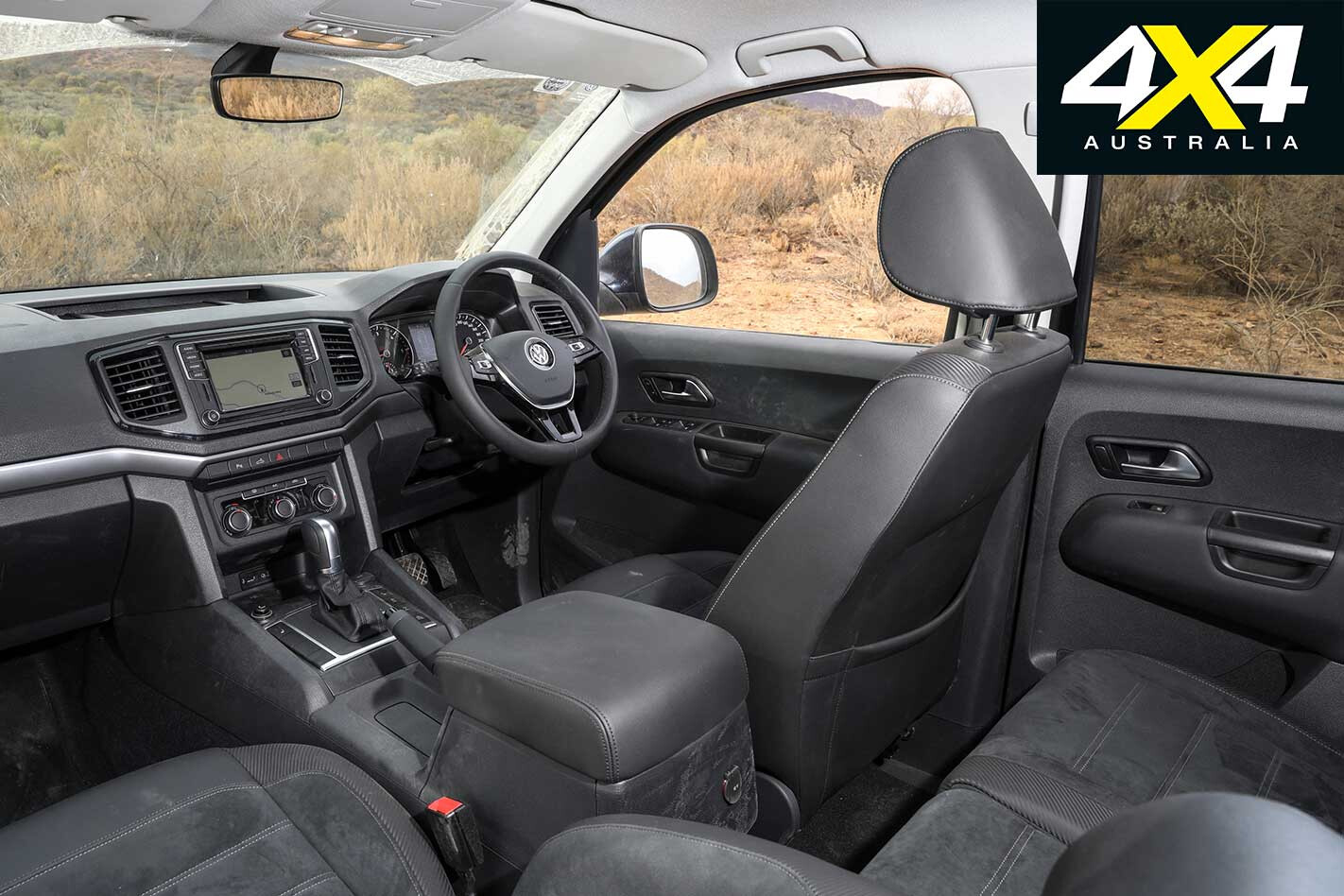
Ours also came with optional satellite-navigation as well as Alcantara trim, for a more elegant seat finish. Even then there are significant omissions, such as rear side airbags, commonplace on rivals. It also misses out on rear air vents and tyre pressure sensors.
If you want the full leather fruit with electric folding seats you’re pushed into the more powerful V6, which can take you to almost $70K. It’s indicative of a car that does things differently.
At two litres in capacity its four-cylinder diesel is by far the smallest here, assisted by one small and one larger turbocharger to provide more huff across its rev range. The 132kW power peak only just slips past the Hilux, while its 420Nm torque figure is outdone by its outback rivals.
However, the Amarok has additional assistance in the form of its eight-speed auto. With more ratios than its contenders it’s a better chance to keep the engine in its sweet spot, with the well-calibrated unit slicing expertly between ratios for elegant, if not astonishing, performance.

It makes for easy progress, either close to the 110km/h limit so common in the outback, or when carving through undulating canyons. There’s a maturity and accessible nature to its drivetrain.
However, it’s the Amarok’s manners that impress most. On country roads there’s a relaxed nature to it, the steering predictable and responsive and the unladen tail behaving close to an SUV in the way it fends off bumps. Throw a few kilos in that broad load area – it can accommodate a pallet between its wheel arches – and the equation is almost as convincing.
Rolling onto gravel roads for the first time also reinforces one of the advantages of the Amarok: its permanent all-wheel drive system. Rather than twirling dials to engage the front wheels, they’re always running, which is ideal for this sort of trip. It’s already set so the driver can forget.
However, as things got rockier up a dry creek bed, there was no option to select low range; the typical low range transfer case simply doesn’t exist on an auto-transmission-equipped Amarok. Fortunately, the torquey engine makes for easy progress in all but the slowest terrain.
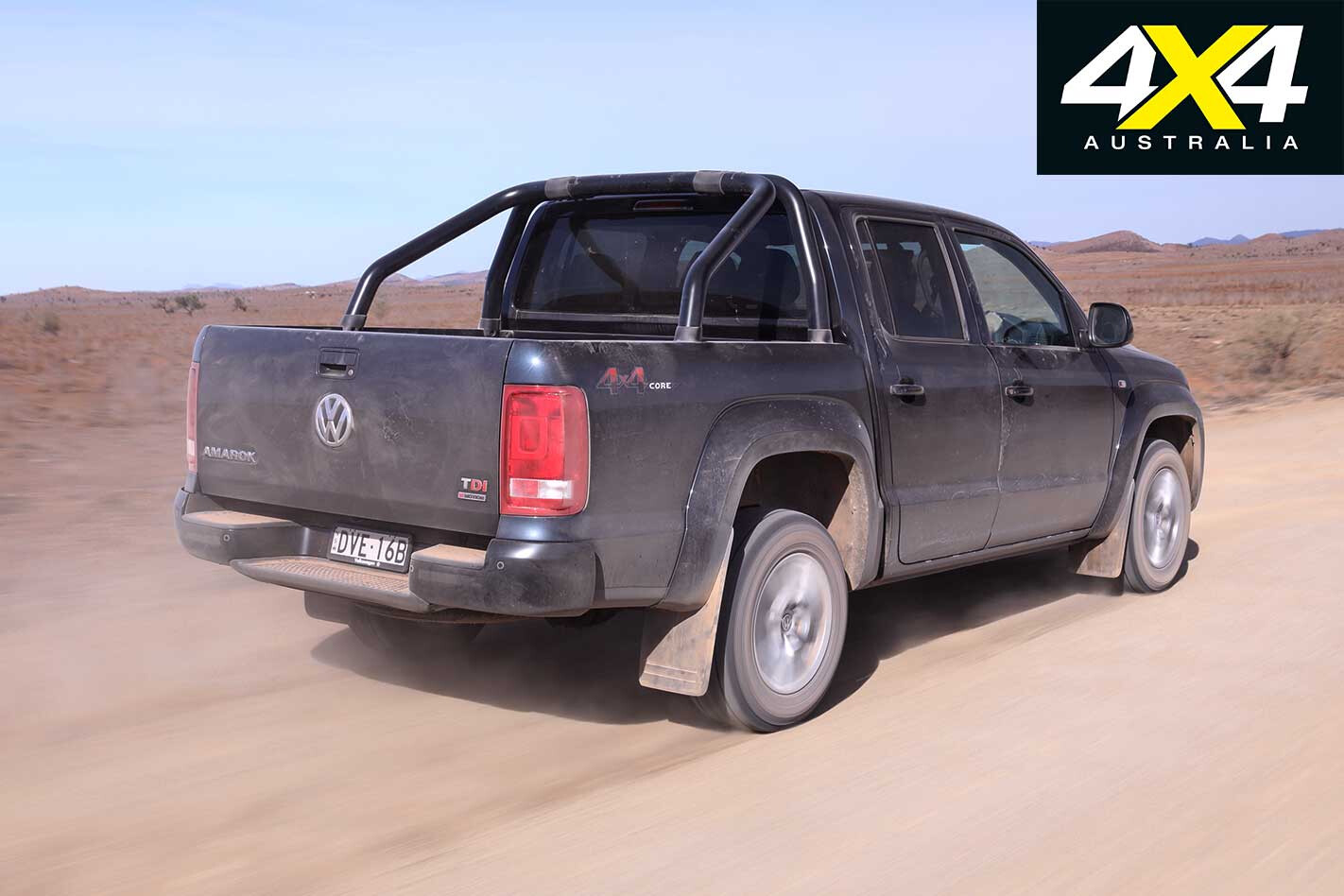
Even without what was once considered essential off-road hardware, the Amarok is mighty impressive in its ability. For our adventure there was nowhere the Amarok shied away from, its generous clearance and articulation teaming with its locking rear diff to shuffle things along with the sort of competency few would expect from high-range only.
We tried the off-road mode that sits alongside the gear selector, but its benefits are minimal and, in many cases on these touring roads, you’re better off leaving it disengaged, allowing slightly friendlier mapping of the transmission.
The Core Plus we tested here ups the wheel size to 17 inches, but they’re still very capable Pirelli Scorpion all-terrains, which worked beautifully on this trip. Keep it out of the really slow going, then, and the Amarok is a tough and capable companion. Its spacious cabin is welcoming and its broad driving demeanour a winner for big adventures.
For those wanting more, it’s comforting knowing there’s a V6 available for good measure too.
2018 Volkswagen Amarok Core Plus Specs: Price: $50,990 (as tested $54,510) Engine: 2.0L 4-cyl twin-turbo-diesel Power: 132kW at 4000rpm Torque: 420Nm at 1750rpm Departure Angle: 23.6° Rampover Angle: 23° Approach Angle: 28° Wading Depth: 500mm Ground Clearance: 192mm
Our Verdict
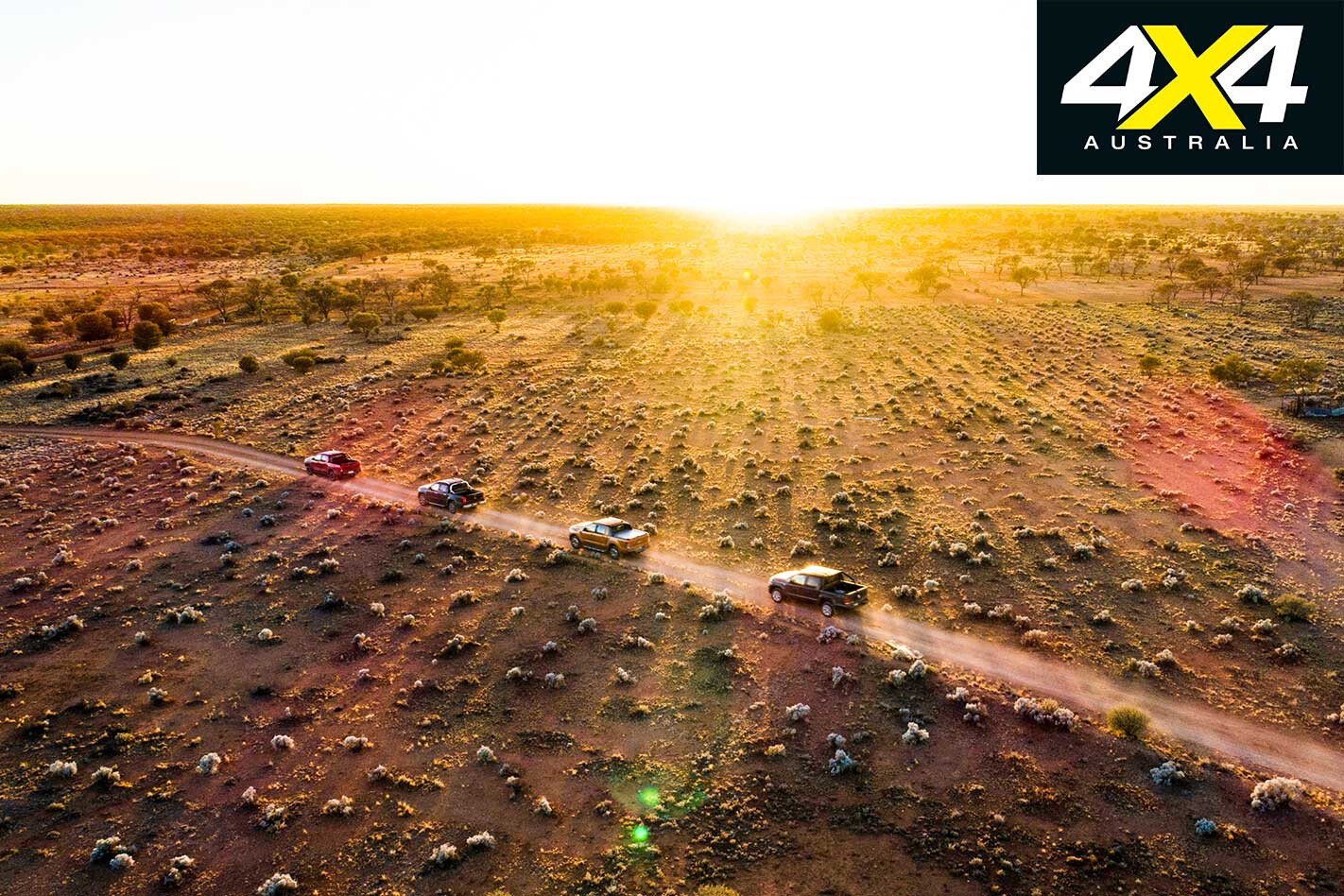
AFTER thousands of kilometres the four-car field was split into two halves – in one sits the Amarok and X-Class.
Sure, the Amarok brings value, space and refined manners to the equation, and the V6 recently took out our nine-ute test. Its combination of space and a brilliant blend of on- and off-road touring make it a terrific value pick, especially in four-cylinder form, but we can’t ignore the lack of rear airbags, which is a shame given the core mechanicals and competency are terrific, with a V6 on offer for those chasing more.
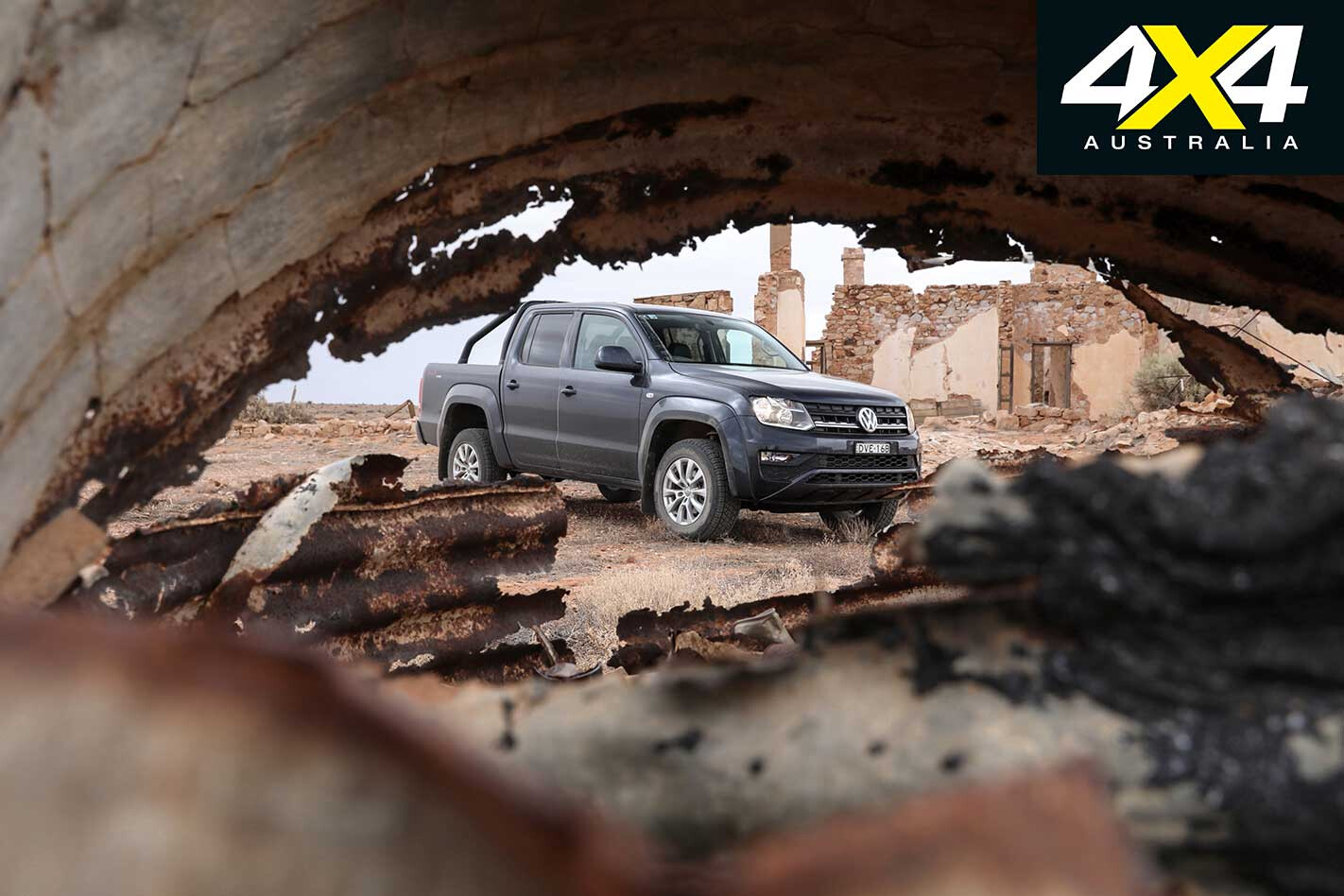
The X-Class brings genuine refinement to the mix and superb safety credentials. With light loads on board its all-coil suspension is also a handy setup, one that is impressively frugal, too, but the hefty price tag and sagging laden rear-end loses points for the X-Class. And if it were our X-Class, we would leave the 19s at home and be happy with smaller wheels and tyres.

This leaves the Hilux and Ranger. There’s a lot to like about the Hilux Rugged X; its unique bumper and superb lighting making it a great machine off-road, teaming with beefed-up recovery points and underbody protection that add assurance out here. It’s a hugely capable ute and one that clearly copes with a pounding … most of the time.
Uncharacteristically, it was quality niggles that let the Hilux down. We’re so used to a Toyota going the distance unfazed, to the point where we expect it. The engine warning, in particular, was a concern, especially as it’s not the first time we’ve encountered it with this 2.8-litre.
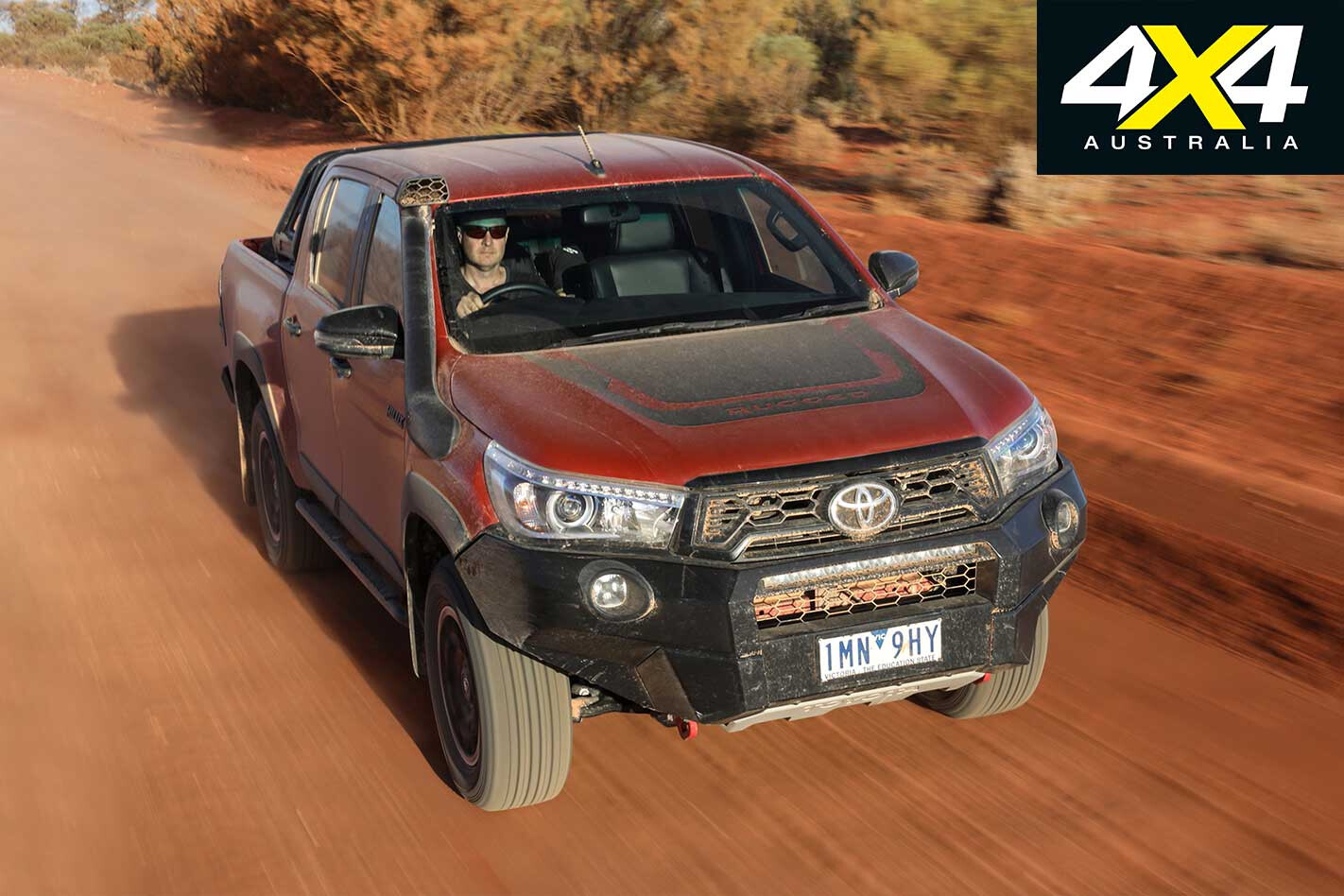
While it seems random and intermittent, it had to be considered when crunching the numbers. Its fuel use and featherweight payload also let the Rugged X down, even if it copes admirably when loaded.
Enter the Ranger. There’s very little to argue against with Ford’s popular dual-cab. It’s great on-road and relaxed and competent off it. A spacious cabin with terrific rear seats also makes for a great family car.
Ultimately, the ageing engine lets it down with refinement, something that should be addressed come facelift time around September when the new 2.0-litre joins the Ranger fray. Even with the 3.2, though, you’re getting a hugely capable and well-balanced ute; one that stands proud and works as well in the outback as it does sauntering back into town.
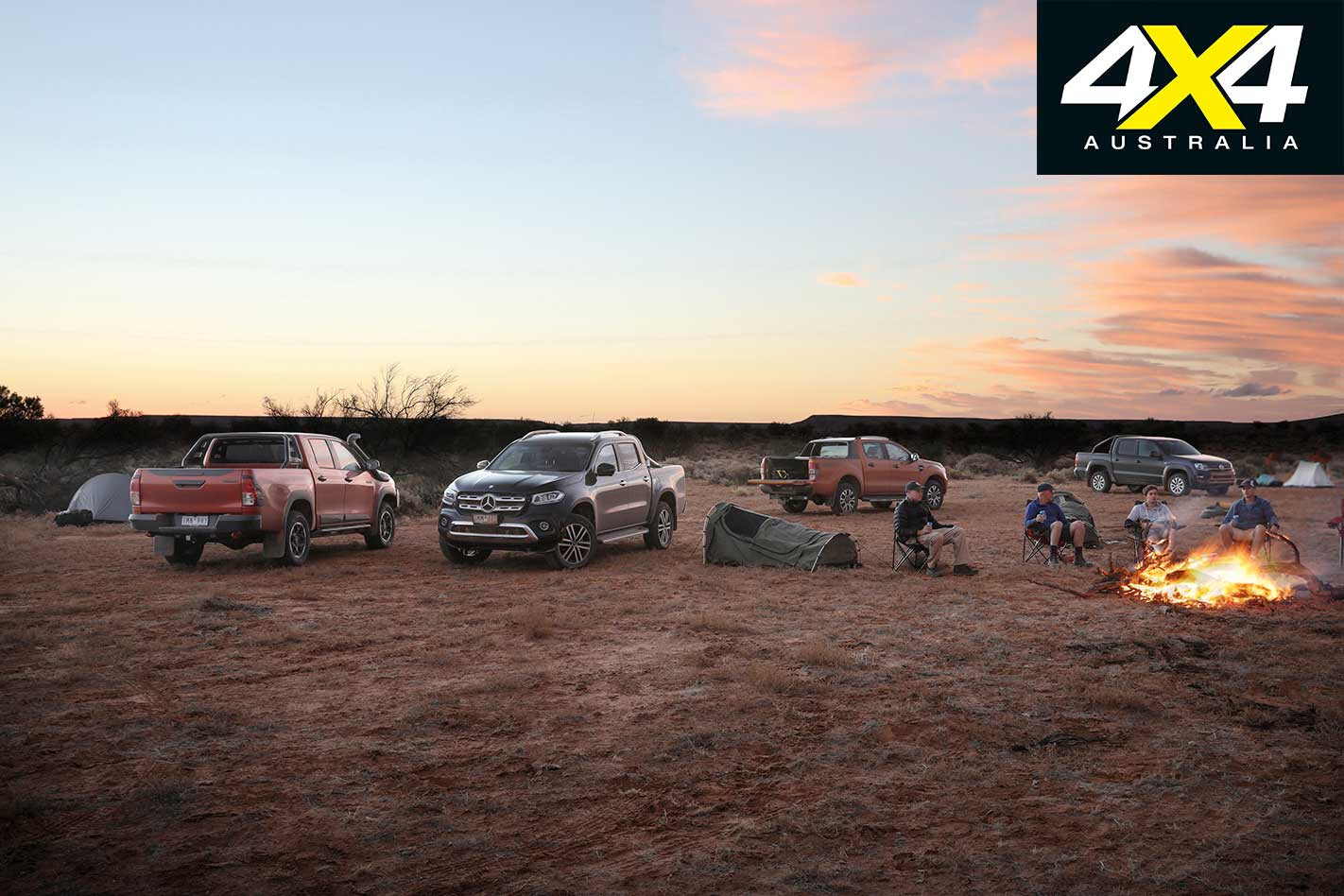
| u00a0 | Ford Ranger Wildtrak | Mercedes-Benz X250d | Toyota Hilux Rugged X | VW Amarok Core Plus |
| Price | $61,790 (as tested $62,340) | $64,500 (as tested $73,300) | $63,690 (as tested $64,240) | $50,990 (as tested $54,510) |
| Engine | 3.2L 5-cyl turbo-diesel | 2.3L 4-cyl twin-turbo diesel | 2.8L 4-cyl turbo-diesel | 2.0L 4-cyl twin-turbo-diesel |
| Power | 147kW @ 3000rpm | 140kW @ 3750rpm | 130kW @ 3400rpm | 132kW @ 4000rpm |
| Torque | 470Nm @ 1750-2500rpm | 450Nm @ 1500-2500rpm | 450Nm @ 1600-2400rpm | 420Nm @ 1750rpm |
| Gearbox | 6-speed auto | 7-speed auto | 6-speed auto | 8-speed auto |
| 4×4 System | Part-time dual-range | Part-time dual-range | Part-time dual-range | Single-range full-time |
| Crawl Ratio | 42.3:1 | 44.3:1 | 36.1:1 | 17.4:1 |
| Tyre | 265/60 R18 | 255/55 R19 (optional) | 265/65 R17 | 245/65 R17 |
| Kerb Weight | 2250kg | 2161kg | 2252kg | 2052kg |
| GVM | 3200kg | 3250kg | 3000kg | 3040kg |
| Payload | 950kg | 1021kg | 748kg | 988kg |
| Towing Capacity | 3500kg | 3500kg | 3200kg | 3000kg |
| Fuel Capacity | 80 litres | 80 litres | 80 litres | 80 litres |
| ADR Fuel Claim | 8.9L/100km | 7.9L/100km | 7.9L/100km | 8.5L/100km |
| Test Fuel Usage | 12.2L/100km | 12.0L/100km | 12.6L/100km | 12.3L/100km |
| Touring Range | 605km | 616km | 585km | 600km |

